Archive for the ‘J Cornell’ Category
Tuesday, July 26th, 2022
“We make a living by what we get;
we make a life by what we give.”
— Winston Curchill
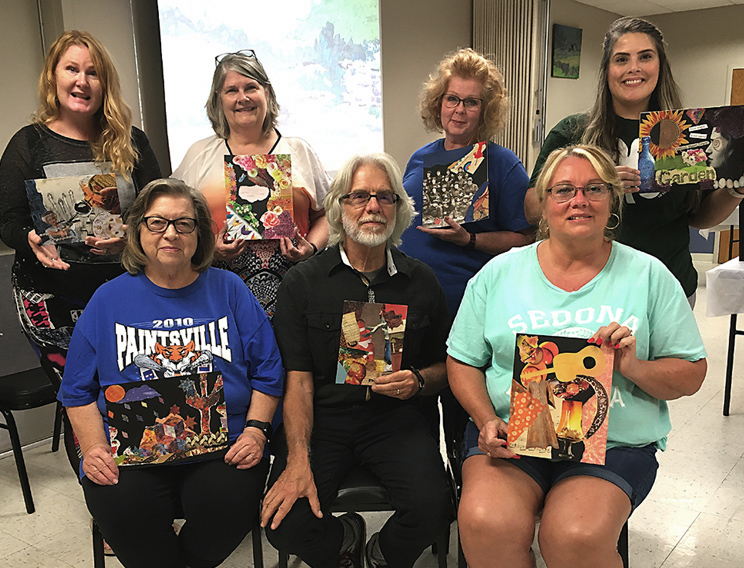 I’m still feeling a satisfying vibe from one of the most personally rewarding events ever! My hands-on collage workshop was part of the “Train the Trainer“ series in Paintsville, Kentucky for the Johnson County Extension Office. Participating artists intend to share this learning throughout their community in the coming months. My thanks to a fabulous group of creative individuals who were curious about “all things collage” and inspired to “pay it forward” among fellow citizens in their beautiful area of our Commonweath.
I’m still feeling a satisfying vibe from one of the most personally rewarding events ever! My hands-on collage workshop was part of the “Train the Trainer“ series in Paintsville, Kentucky for the Johnson County Extension Office. Participating artists intend to share this learning throughout their community in the coming months. My thanks to a fabulous group of creative individuals who were curious about “all things collage” and inspired to “pay it forward” among fellow citizens in their beautiful area of our Commonweath.
After an opening presentation with my whirlwind tour through over 200 years of collage history, a demonstration offered cutting tips, the basics of pasting technique, an overview of translucency and transfers, plus an emphasis on maintaining the flow of improvisational layering. (See my end-result demo piece below.) Throughout the day we stressed the fundamentals of visual aesthetics, while keeping our focus on intuitive spontaneity within an experimental process. Tables cluttered with potential ingredients were the norm, as participants tackled three time-based exercises and produced a collage miniature for each. Their well-crafted, colorful solutions were the take-home product, and we managed to fit in a closing discussion full of important observations. I was impressed with the group’s talent, curiosity, and spirit of creative adventure! It was an astonishing thing for me to observe how fluently they attuned to the vocabulary of collage expression, having no prior awareness of Hannah Höch, Joseph Cornell, or the Merz of Kurt Schwitters.
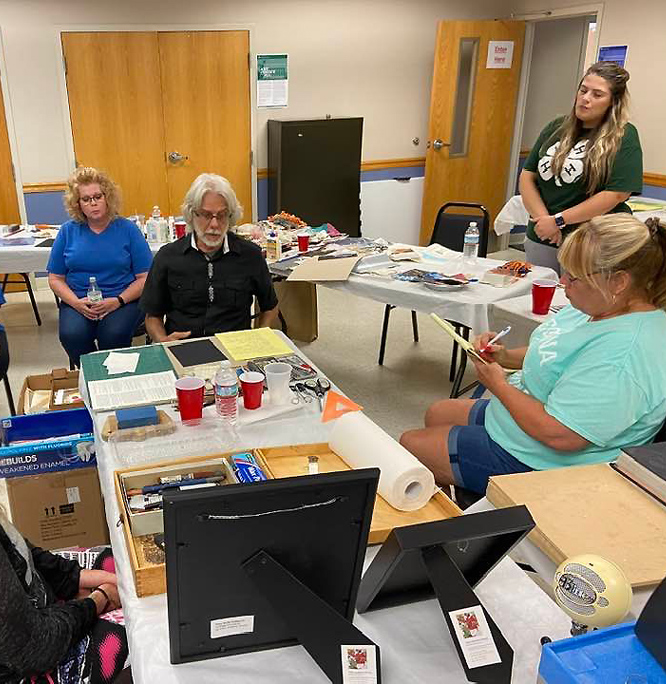
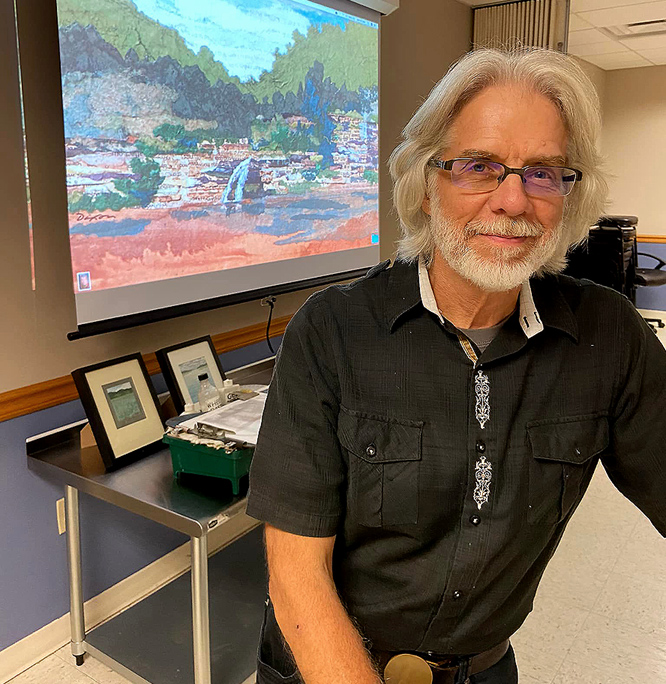

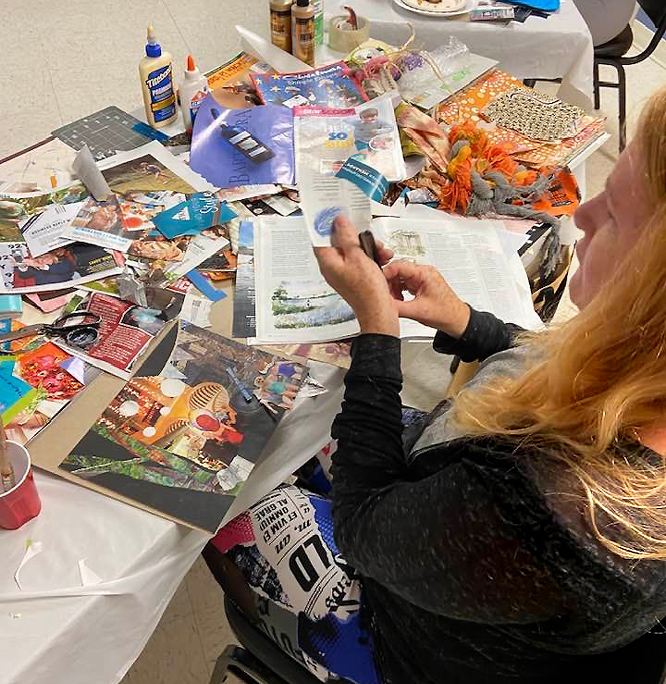
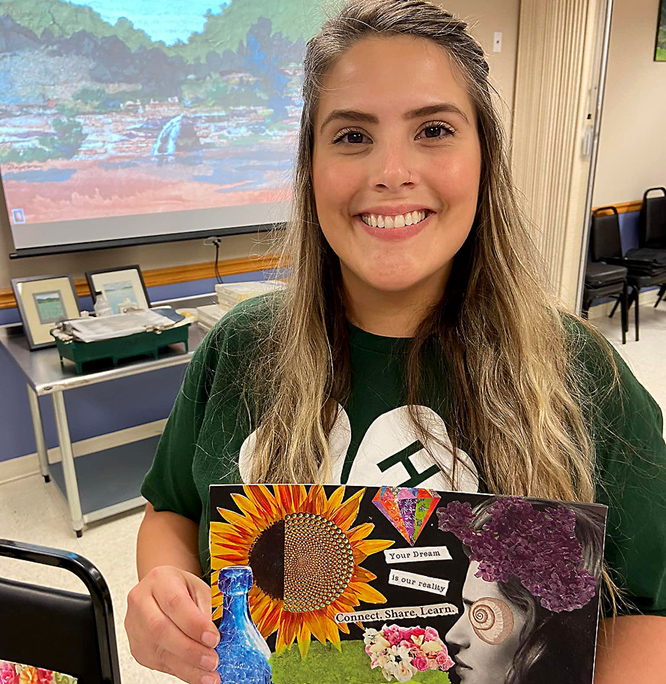

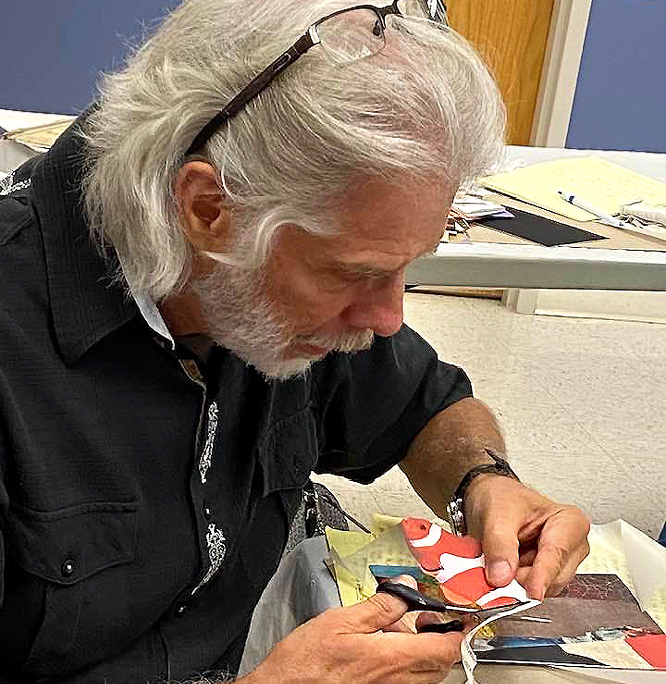
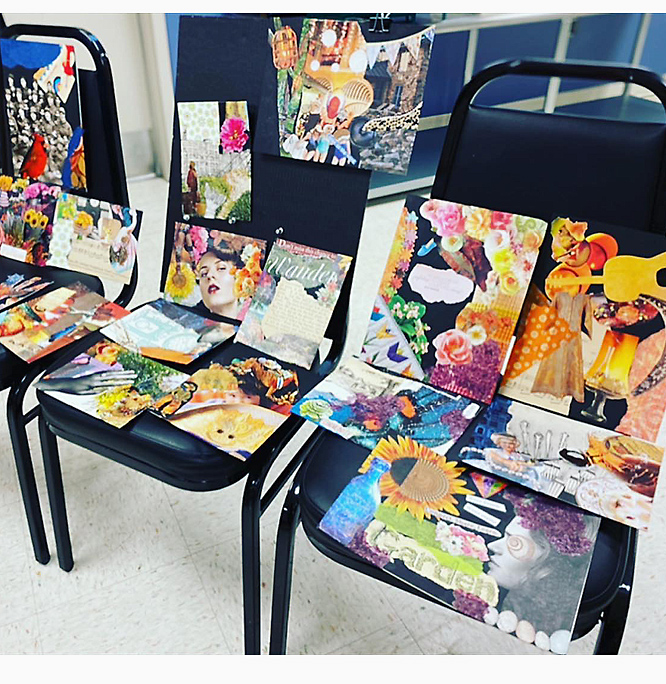

It’s been a while since I accepted the role of teacher. I was surprised and concerned to discover that it was no longer within my “comfort zone.” I faced a gauntlet of self-assurance to run before I felt prepared. The delightful, encouraging Brenda Cockerham, our project leader, provided vital support. As ever, Dana was an indispensable “partner in all things.” Why must I periodically be reminded that giving back is every bit as significant as anything I get from my artistic practice? I’m a fortunate man, because cutting and pasting offers a universal experience that is effortless to share with others — if I just get out of my own way. Collage at all levels presents an ideal opportunity for individual receptivity. It’s rewarding to watch this sense of discovery, similar to what I experience myself as I explore the wide potential of art made from paper that would otherwise be cast away. This connection with others fires my enthusiasm to compile additional collage insights and to continue passing them along. There is much to gain within a shared creative environment when we take discarded stuff and create value where none existed, and find wonder, meaning, and beauty where none had been expected.
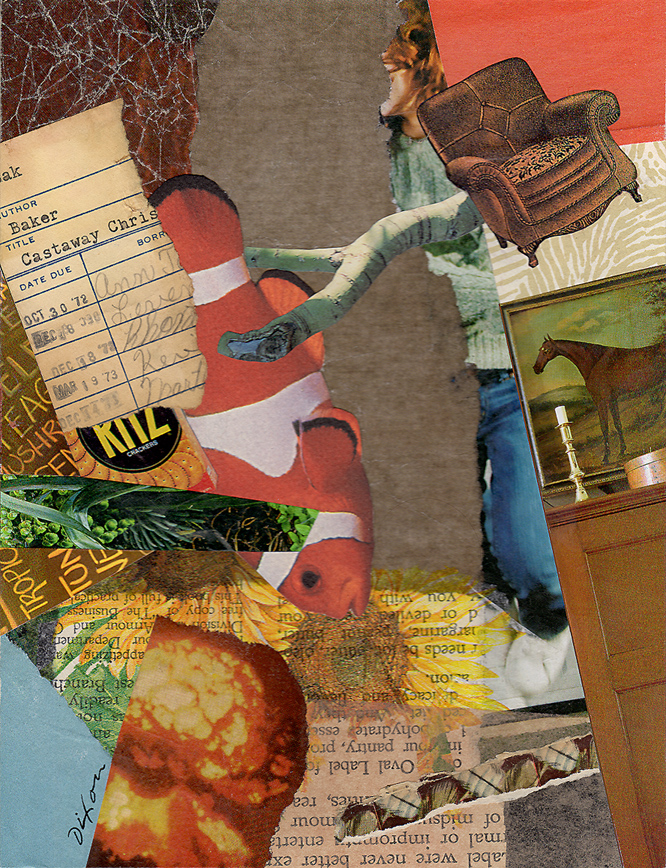
Don’t Clown Around
collage experiment by J A Dixon
created during my workshop demonstration
6.5 x 8.5 inches
Posted in Collaboration, Constraints, Demonstrations, Events, Experiments, H Höch, Influences, Ingredients, J Cornell, K Schwitters, Merz, Technique | No Comments »
Monday, January 20th, 2020
“. . .this is what we do in the collage community: we engage, we exchange, we manifest with one another. We emerge into a new state of being together. That is what makes art powerful. It connects us and takes us into the future.”
— Ric Kasini Kadour
Any collage artist who maintains even a casual curiosity about the legacy of Kurt Schwitters has to be enthusiastic about developments in Sanquhar. As someone who employs this space to exalt the “Master of Merz” without apology, I now feel compelled to praise Ric Kasini Kadour and his worldwide call to built a Schwitters’ Army collection of collage artwork at the center for learning established by David Rushton in the Scots town. Needless to say to an audience that visits this site with an interest in all things collage, Ric has made an impressive effort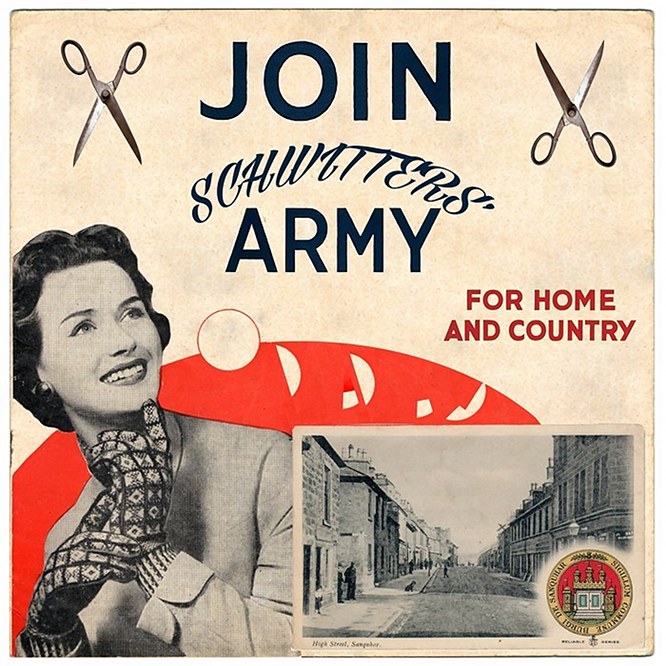 over the past few years to raise the level of discourse about a medium to which so many of us have dedicated ourselves. From Kolaj Magazine to Kolaj Institute to Kolaj Fest, he’s been making his mark for some time and clearly doesn’t intend to rest on his laurels.
over the past few years to raise the level of discourse about a medium to which so many of us have dedicated ourselves. From Kolaj Magazine to Kolaj Institute to Kolaj Fest, he’s been making his mark for some time and clearly doesn’t intend to rest on his laurels.
As part of his curatorial efforts at MERZ Gallery, he has asked contributing collage artists to answer a few questions. As I prepare to ship my donation to the cause, I’ll publish my supporting remarks here for your potential interest.
Next time: a look at the artwork and my thoughts about the context of its creation.
What is your origin story? When did you first start making collage seriously?
The first collage art that I remember creating was in the 4th or 5th grade, probably in 1961 or 1962, when I used sample chips of color from a paint store to cut and paste a mosaic-like image that won the “Poppy Day” poster contest. It’s always stood out in my memory. I thought of myself as an artist from that point forward. Nevertheless, up into high school, I would feel the lack of any competent art instruction as a keen deprivation. I convinced my parents in 1967 to enroll me as a charter student in the home-study course co-founded by Norman Rockwell called “The Famous Artists Course for Talented Young People.” Unlike the successful version for adults on which it was patterned, the package of guided assignments for teens would fail in the marketplace, but not before exposing me to a diversity of fine and applied art mediums, including collage.
Who was the first collage artist you connected with?
The Famous Artists Course would bring to my awareness many influences in the area of collage and assemblage, including Fred Otnes, Robert Rauschenberg, Louise Nevelson, Joseph Cornell, and Kurt Schwitters. Although I didn’t understand his technical methods, I initially attached my affection to the visually comprehensible Otnes, and I’d emulate his montage approach throughout my years as a professional illustrator and designer. In contrast, a series of breakthroughs in my journey to unravel the Merz of Schwitters would take another forty years, culminating in my first solo exhibition as a collage artist in 2007.
How do you connect with the collage community?
I began writing about collage and showcasing my practice at “The Collage Miniaturist” in 2012. Since then, beginning with fellow artists in Kentucky who work in the medium, I’ve collaborated with a body of dedicated collage artists. I’ve also regularly entered pieces in national and international calls for collage and submitted my work to landmark exhibitions and permanent collections. Believing that cross-pollination in collage through worldwide virtual communities is a vital force in the so-called “Post-Centennial” collage movement, I follow hundreds of active collage artists through social networks. As much as possible for someone who continues to sustain an ongoing studio and exhibition schedule, I regularly comment on trending topics and answer questions in the digital realm.
Posted in Assemblage, Collaboration, Collage, F Otnes, Influences, J A Dixon, J Cornell, K Schwitters, L Nevelson, Links, Merz, N Rockwell, R K Kadour, R Rauschenberg | No Comments »
Saturday, March 10th, 2018
“In the ’20s, dadaist Kurt Schwitters collected bits of detritus such as cigar bands and bus tickets and used them in collages. They were shocking then but with the passage of time have taken on the aura of classics: vibrantly colored and harmonious arrangements of abstract forms and only incidentally assemblages of junk.”
— John Ashbery
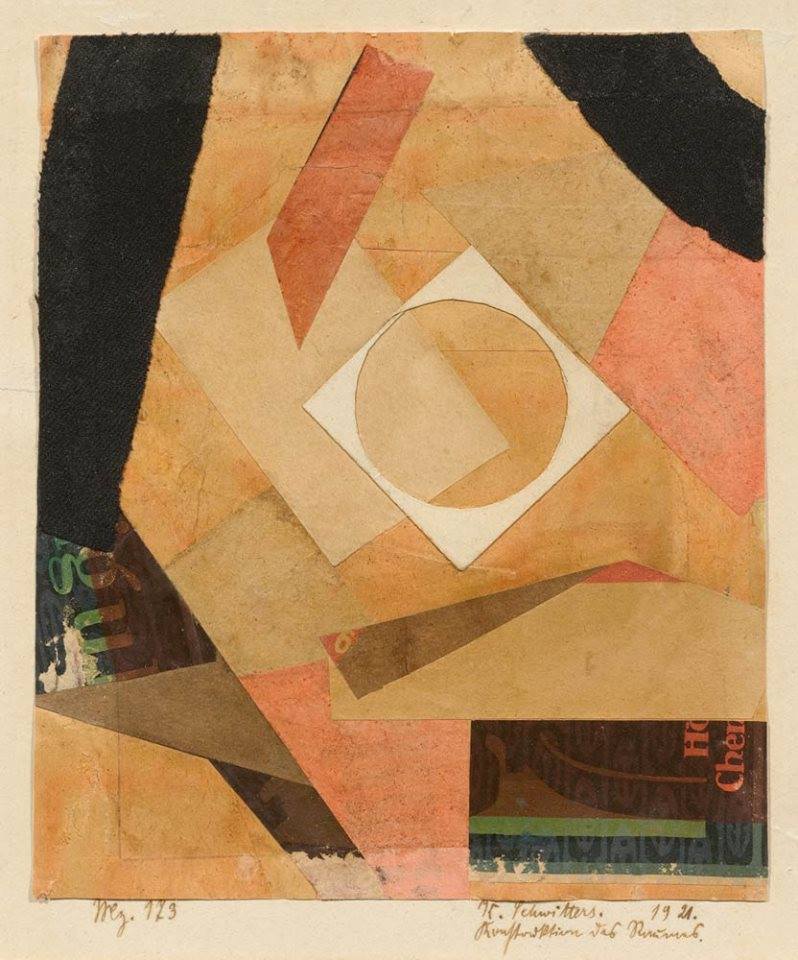
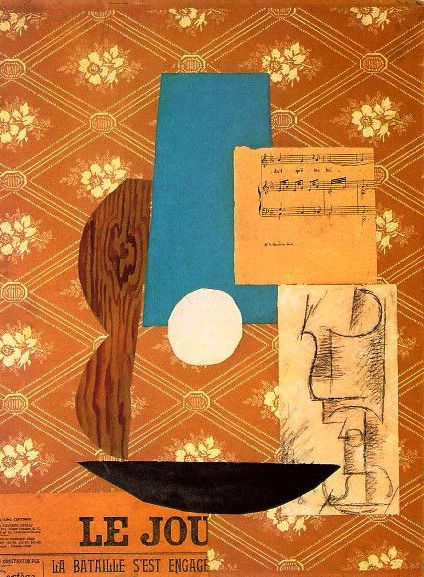 About a hundred years ago, a handful of Europeans had set out to invent what we now know as the medium of collage. Nearly all of them were painters. From the beginning, collage was rooted in modern art concepts that were emerging at the same time — the fundamentals of abstraction. Thus, the evolution of abstraction and collage in the 20th century are entwined, and remain so in a burst of contemporary activity in this post-centennial period. Next year will mark a full century of Merz. Artists working in collage abstraction carry the “creative code” of Kurt Schwitters and his seminal innovations.
About a hundred years ago, a handful of Europeans had set out to invent what we now know as the medium of collage. Nearly all of them were painters. From the beginning, collage was rooted in modern art concepts that were emerging at the same time — the fundamentals of abstraction. Thus, the evolution of abstraction and collage in the 20th century are entwined, and remain so in a burst of contemporary activity in this post-centennial period. Next year will mark a full century of Merz. Artists working in collage abstraction carry the “creative code” of Kurt Schwitters and his seminal innovations. 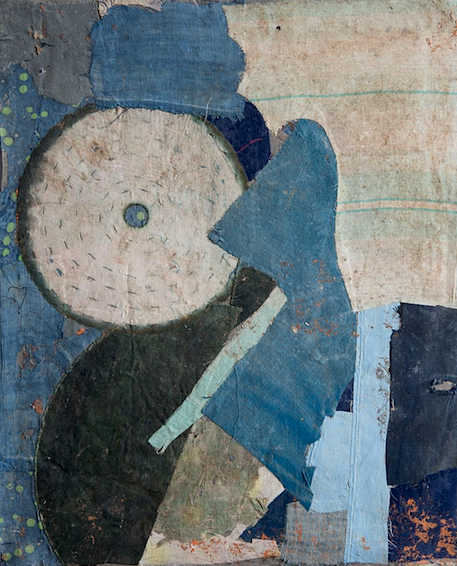 But, allow me to pause here and point out something that has become increasingly obvious: conventional art history was woefully male centered. Intentionally or not, the discipline would downplay or ignore many exceptional women artists, and that includes collage antecedents which were largely the domain of females, especially in the domestic or folk arts. For example, an interesting feature at moowon.com highlights the forgotten art of Chinese textile collage.
But, allow me to pause here and point out something that has become increasingly obvious: conventional art history was woefully male centered. Intentionally or not, the discipline would downplay or ignore many exceptional women artists, and that includes collage antecedents which were largely the domain of females, especially in the domestic or folk arts. For example, an interesting feature at moowon.com highlights the forgotten art of Chinese textile collage. 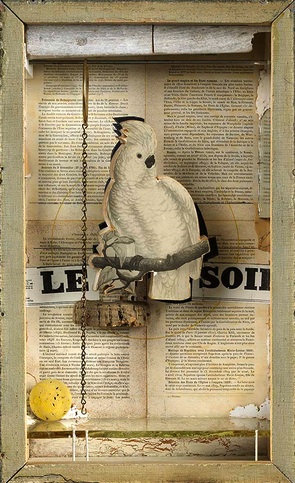 Picasso lifted visual ideas from tribal cultures. Cornell borrowed techniques tied directly to Victorian crafts. We understand that now. Modern art did not spring fully formed from the brow of Zeus like the armored goddess Athena. Fast forward to 2018. Many of the most accomplished and widely recognized collage artists of today are women. And the best part is that we know about them.
Picasso lifted visual ideas from tribal cultures. Cornell borrowed techniques tied directly to Victorian crafts. We understand that now. Modern art did not spring fully formed from the brow of Zeus like the armored goddess Athena. Fast forward to 2018. Many of the most accomplished and widely recognized collage artists of today are women. And the best part is that we know about them.
Melinda Tidwell is one of the dedicated abstractionists in collage that I enjoy following. She has a solid and very articulate designer “upstairs” guiding each decision, but her regard for the unexpected is a strong part of her intuition. Last summer, she published a two-part discussion of “order versus disorder” at her blogsite. It features abstractions by Lance Letscher and is well worth checking out.
Please indulge me as I share examples of collage abstraction from artists who continue to favorably capture my eye. Some of them range into mixed media in a way that remains very much collage. Others are strictly “painting with paper.”
Merz is alive and well in the 21st century, my friends.
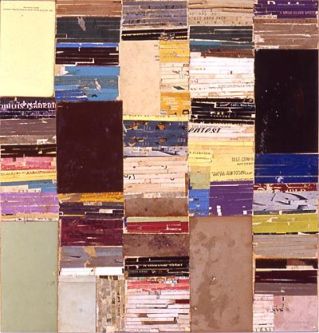
(title unknown)
abstract collage by L Letscher
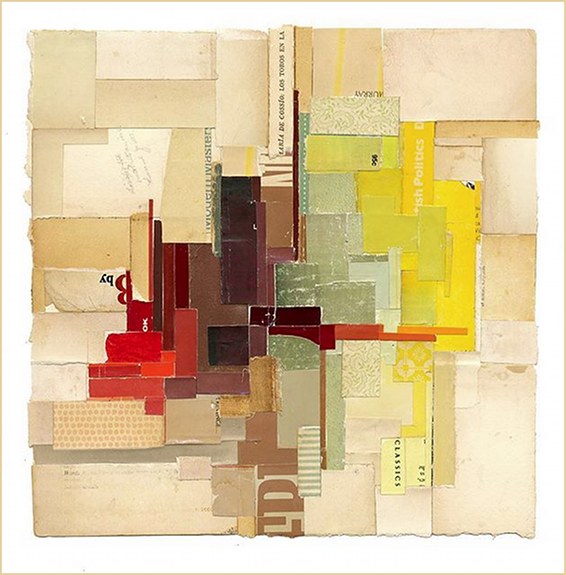
(title unknown)
abstract collage by M Tidwell
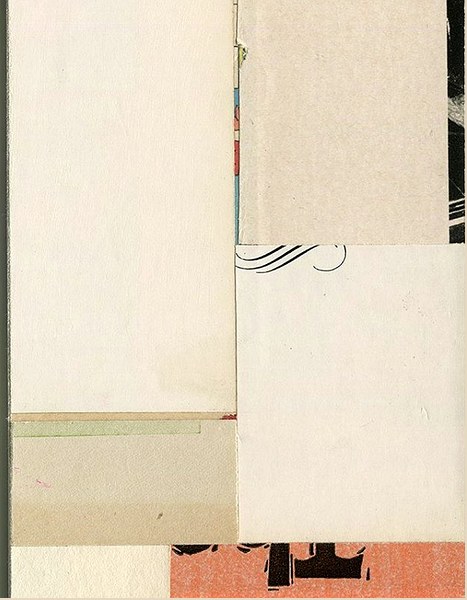
11zc18
abstract collage by Z Collins
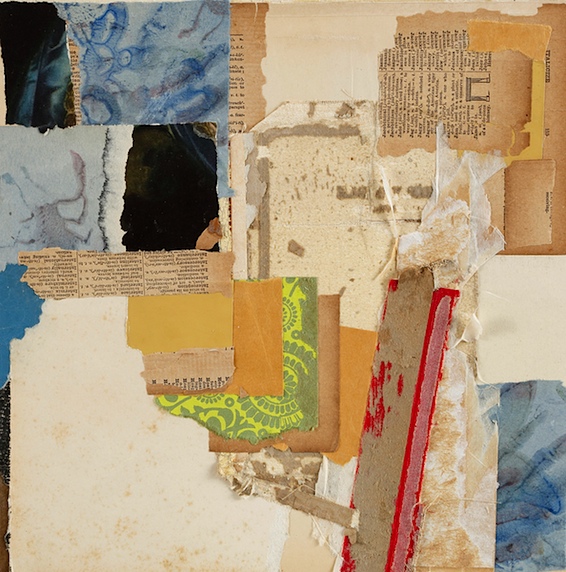
Elysburg IV
abstract collage by C Chapman
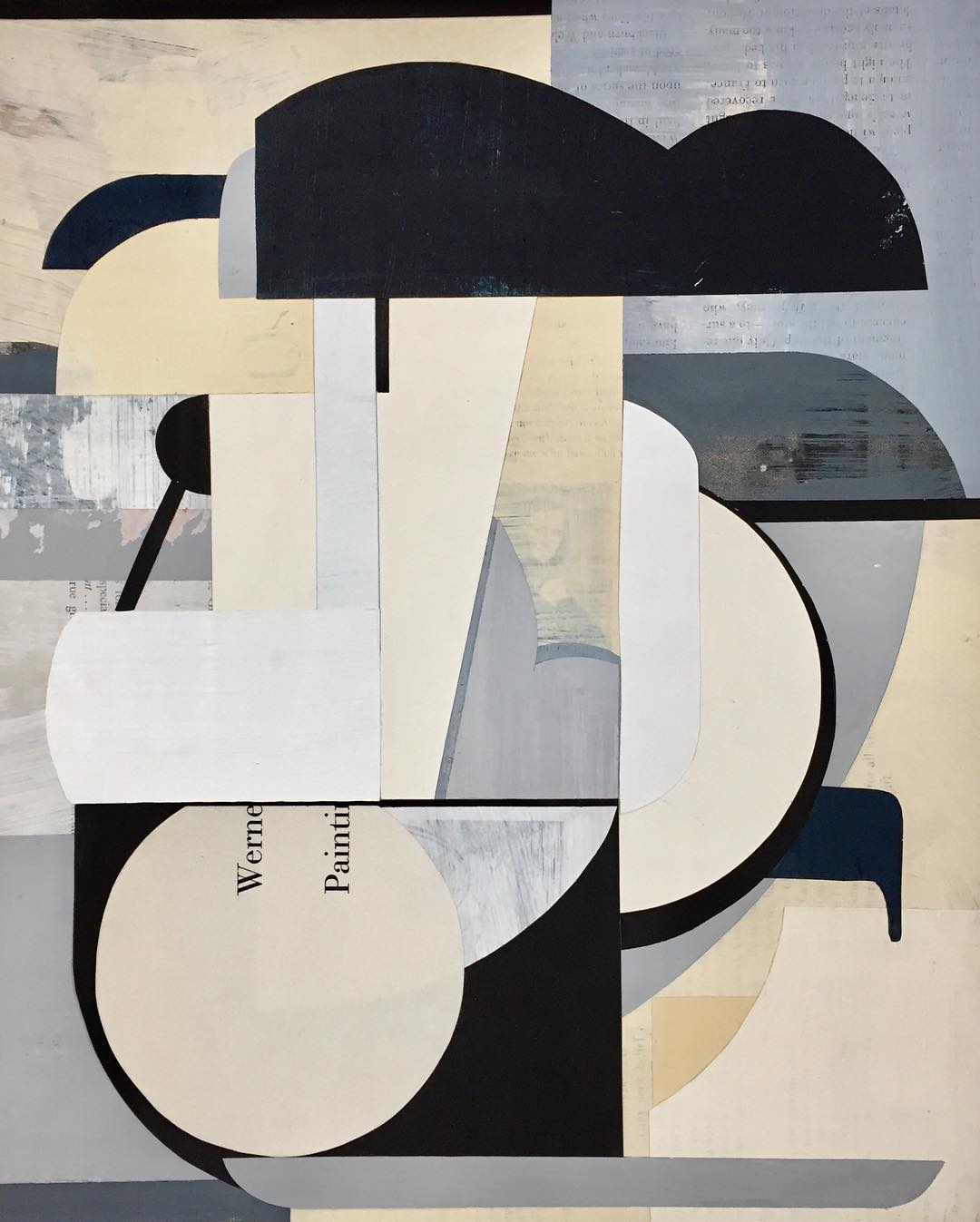
Ellington
abstract collage by D McKenna
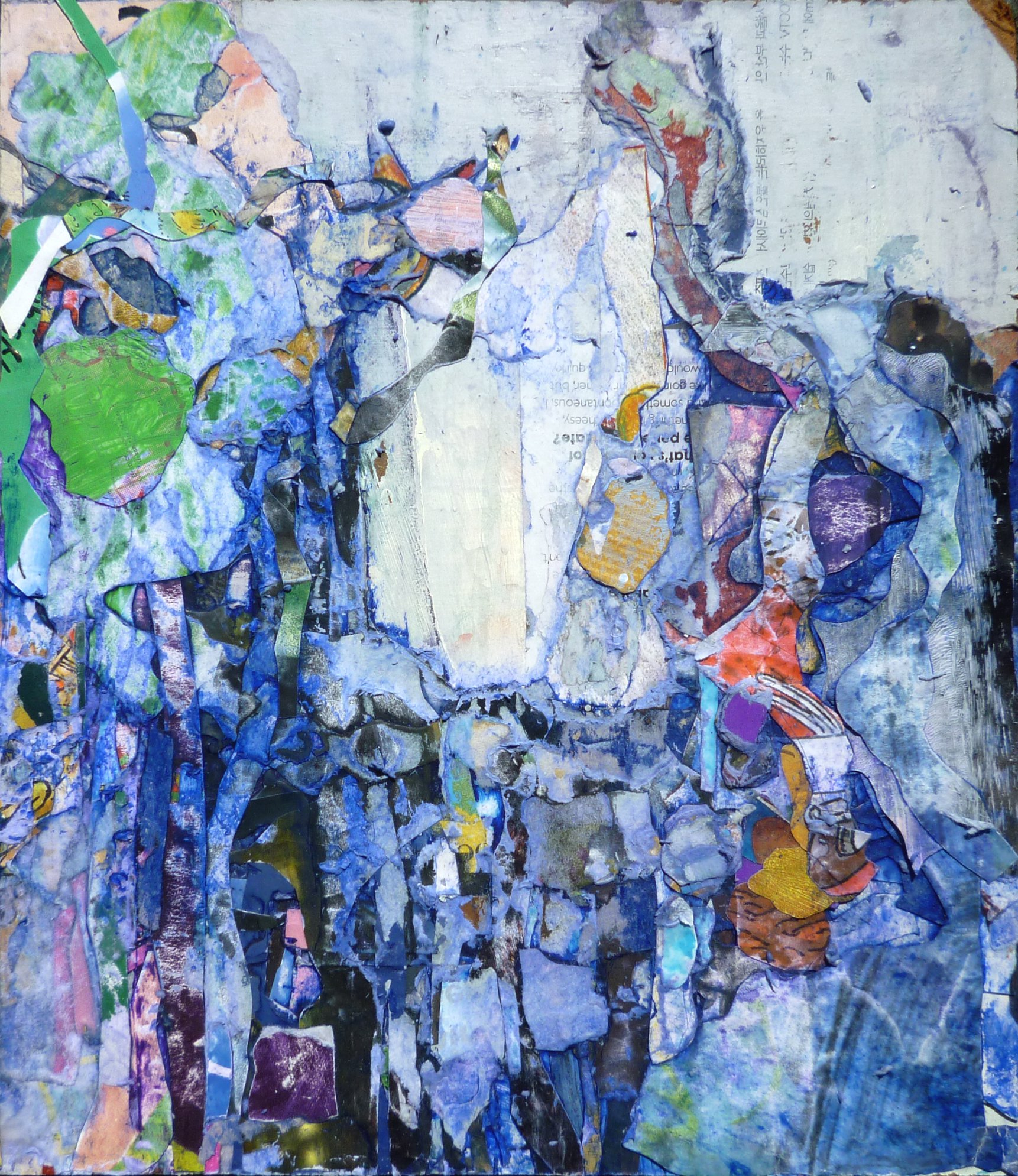
Osmosis 3
abstract collage by C Emeleus
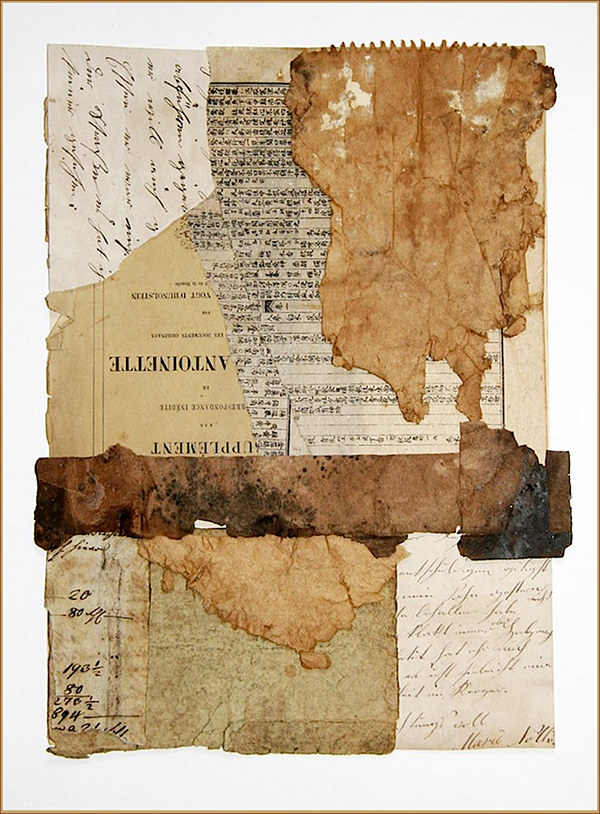
Antoinette
abstract collage by W Strempler
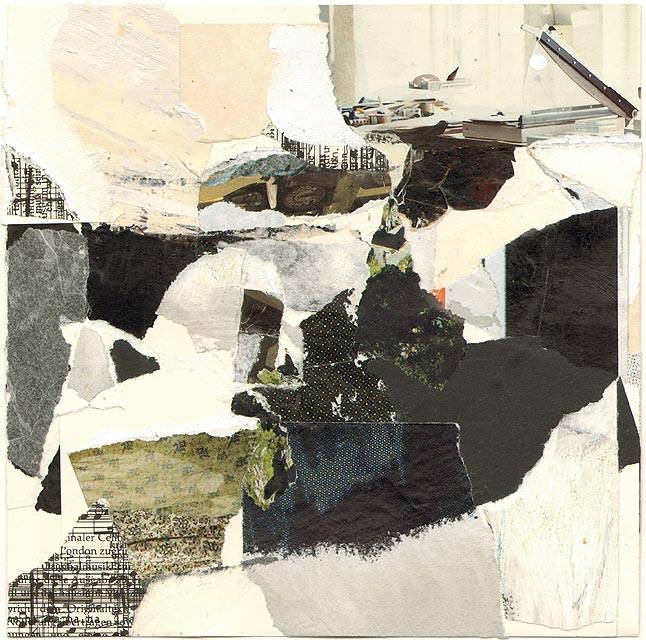
Music
abstract collage by S Kraft
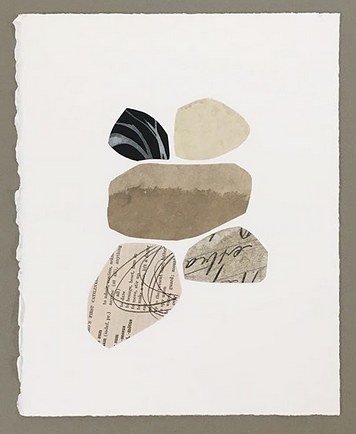
from her series, BALANCE
abstract collage by S A Herman
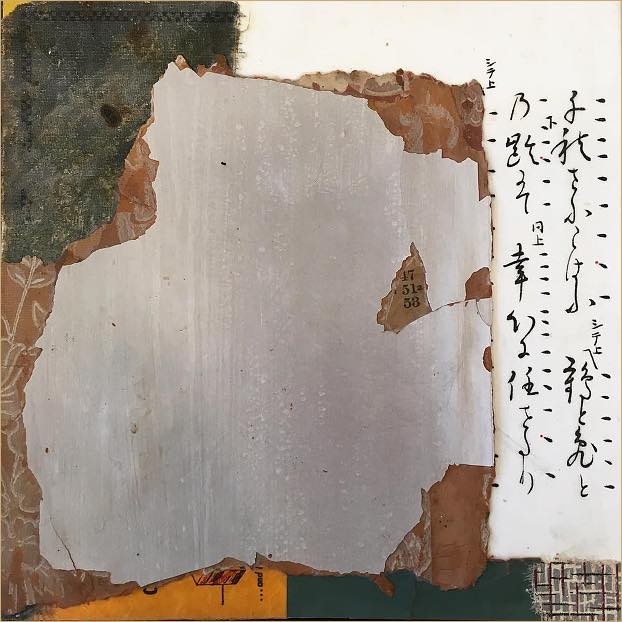
Day 18 of 40
abstract collage by C Neubauer
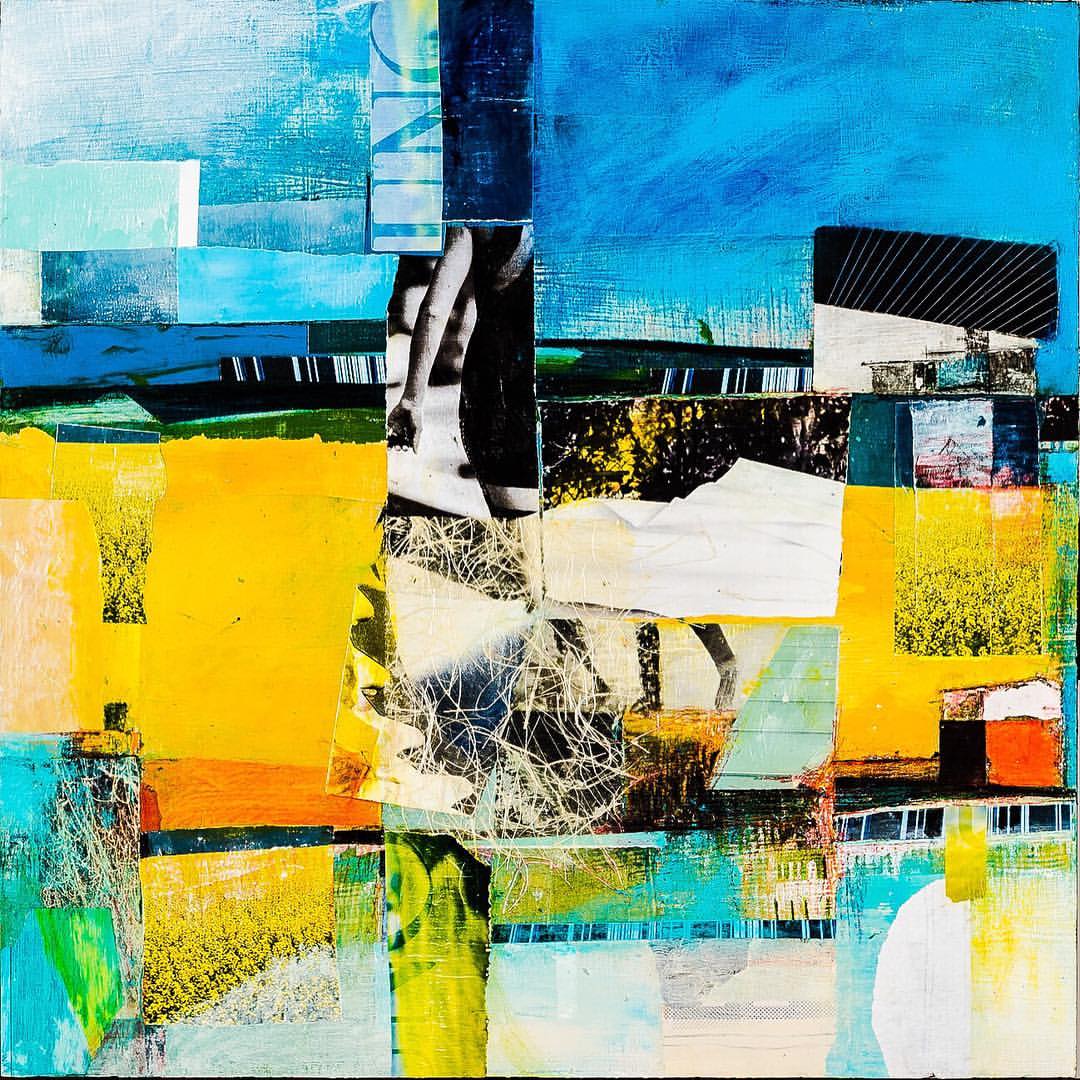
Red Cottage — from her series, SENSE OF PLACE
abstract collage by P A Turner
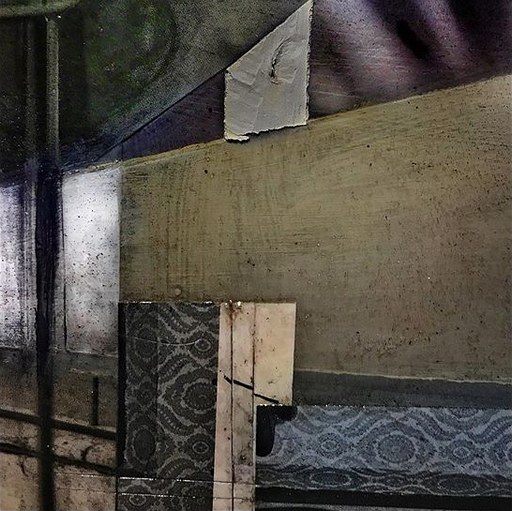
(title unknown)
abstract collage by J C Martin
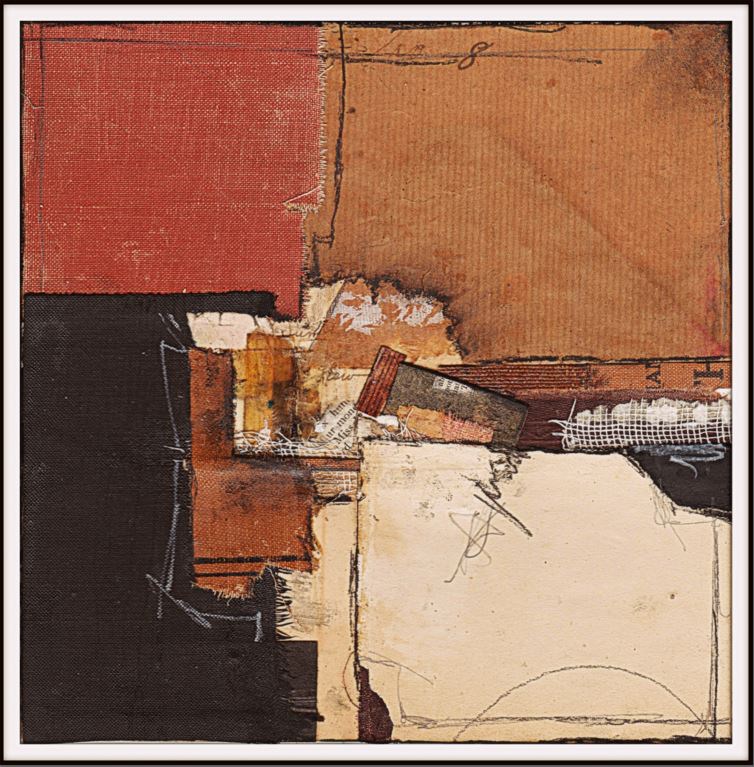
Reap
abstract collage by G Cooper
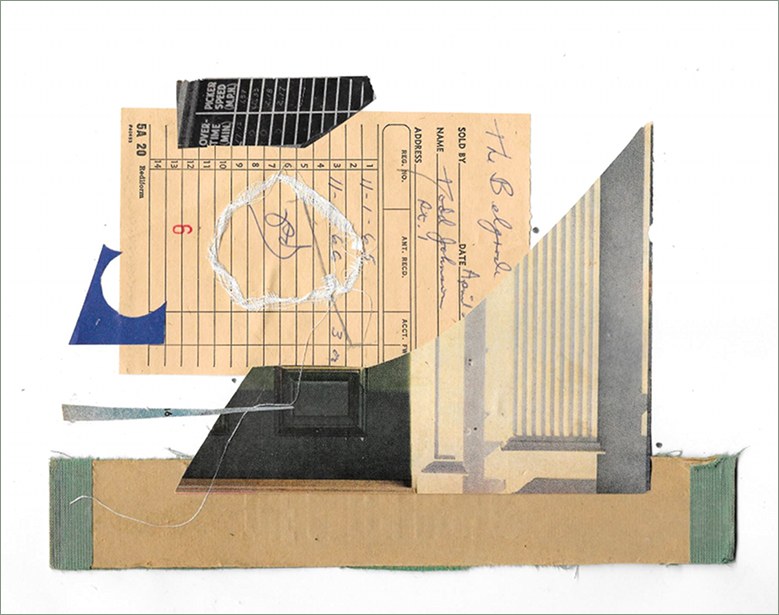
Cognitives and Conclusions
abstract collage by S Ringler
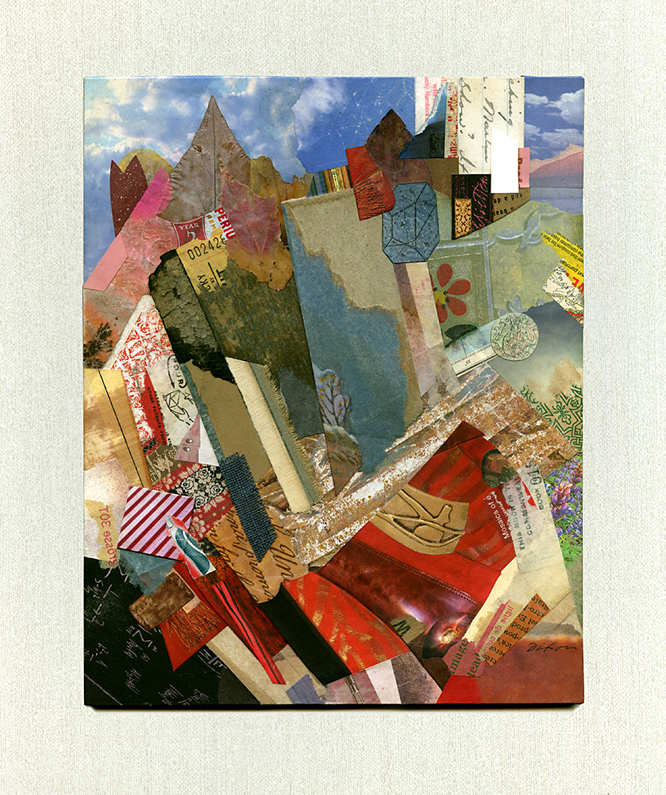
Dynamic Stability
abstract collage by J A Dixon
Purchase this artwork.
Posted in Abstraction, C Chapman, C Emeleus, C Neubauer, Collage, Cubism, D Ellington, D McKenna, Folk Art, G Cooper, Influences, J A Dixon, J C Martin, J Cornell, J Gris, K Schwitters, L Letscher, M Tidwell, Merz, P A Turner, P Picasso, S A Herman, S Kraft, S Ringler, W Strempler, Z Collins | No Comments »
Saturday, January 13th, 2018
“I have always tried to exploit the photograph. I use it like color, or as the poet uses the word.”
— Hannah Höch
It is always a temptation for a so-called blogger to dangle a “best of” or “top twenty” list to entice a visitor, and, of course, we see this tactic used almost on a daily basis in various fields of art and entertainment. How many of us have gone online and swallowed just such a colorful lure? On the most obvious level, the whole stimulus-response thing is a bit silly, but the potential to learn something new does exist, or to sharpen our own sense of quality, preference, and discernment. Each of us is free to have viewpoints, as long as we recognize them as personal opinions, and avoid casting them about as certitude. Isn’t there enough of that going on these days? (Yes, dear guest, that is merely my perspective.) 
What does this have to do with collage? Well, I just paid a visit to a page at AnotherMag.com (in response to the aforesaid bait), and I learned for the first time about three collage artists who were new to me, a working artist who purports to ruminate on “all things collage.” In this particular case, there may have been an explicit effort to achieve an overdue gender balance for a post intended to spotlight the Höch retrospective at the Whitechapel Gallery in London, but one could question the absence of Paolozzi, Rauschenberg, Johnson, Hamilton, or Kolář. To not include at least one of these men as a key figure in the history of collage brings no meaningful discredit on any of the artists, but only on the list. (And that, too, is just my opinion).
Nevertheless, I am not ashamed to accentuate the gaps in my collage literacy and to feature three noteworthy female artists: Eileen Agar, Nancy Spero, and Annegret Soltau. Examples of their work should have appeared here long before now.

Woman reading
by Eileen Agar, 1936
Museum of New Zealand

Protagonists
by Nancy Spero, 1989
disposition unknown

Grima – mit Katze
by Annegret Soltau, from her 1986-97 series
Vero Group Collection, Houston, Texas
Posted in A Soltau, Assemblage, Collage, Criticism, Dada, E Agar, E Paolozzi, Exhibitions, G Braque, H Höch, Influences, J Cornell, J Kolář, J Stezaker, J Treece, K Schwitters, Links, M Ray, Merz, N Spero, P Donley, R Hausmann, R Johnson, R Rauschenberg, Surrealism | No Comments »
Monday, February 29th, 2016
Friend and fellow collage artist Kathleen O’Brien is in the midst of her countdown to a big solo show in April. She asked me to do a favor and share a guest review as part of her final promotions for JUXTAPOSE before Drawn to the Earth requires her full concentration. As excited as I am about the group exhibition in Danville, it was a tougher post to write than I first anticipated. Collage is not the easiest art form on which to expound, perhaps because it relies on the “logic” of irrational choices.
At any rate, my dedicating a blogsite to that very topic was nobody else’s idea, so I best not complain to those of you kind enough to visit here. Would I rather be making art? Of course. Even so, I cannot constrain my enthusiasm for all things collage. Here’s my take on a great show. Be forewarned: If you’re looking for some criticism, you won’t find it!
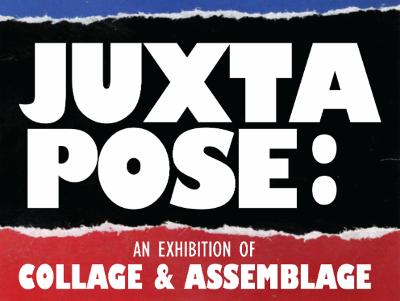


I’ll admit it. I can’t get enough of JUXTAPOSE. The current exhibition of collage and assemblage is at the Community Arts Center until April 2nd. That’s not exactly the most humble thing to say, considering it features a dozen works by yours truly, so I won’t pretend that I can offer an unbiased review. Program director Brandon Long has organized a finely curated, must-see destination that brings together over a thousand examples of the two associated mediums (literally, but I’ll explain that in a moment). This is an unprecedented group show for the Bluegrass-based artists involved, and I am thrilled to be exhibiting side-by-side with Kathleen O’Brien, Teri Dryden, Robert Hugh Hunt, Meg Higgins, Connie Beale, Cynthia Carr, and many others. No doubt my enthusiasm has something to do with its location less than a city block from my studio, which bestows the luxury of repeated immersions, and there is over a month left in the duration!
There are more participants than I can profile individually, and far too many artworks to highlight. The best example of this is a room devoted to three complete year-long series of collage-a-day works by O’Brien, Long, and Nan Martindale. Combined with almost one hundred seventy of Robert Hugh Hunt’s provocative collage collaborations, the magnitude of miniature artworks presented in a single space could be overwhelming. As an exhibition designer, Long uses geometric grids, browsing boxes, and two flat-screen displays to make the huge collection comprehensible for viewers. O’Brien’s sensitive, meticulously layered collection of daily two-sided postcards is a journey to which I surrender with pleasure each time I visit, but only after a jolting romp through Hunt’s rarely exhibited Hillbilly Voodoo series with T R Flowers.
An opportunity to view works by six outstanding Louisville-based artists is worth the trip to Danville. Several major works by Meg Higgins captured my first impression. Two enormous pieces composed with transparent elements sandwiched between Plexiglas are suspended between the vestibule and grand gallery. I was equally impressed by a smaller collage on wood panel, Japanese Peony Goes to Italy, with its exquisite East-West flavor. Brad Devlin’s solid but clever exploitation of found objects yields bold abstractions that simultaneously maintain a strong environmental essence. His Open Sunday is also physically more complex than it first appears, and this allows the artisanship of his assemblage to become a secondary experience deserving of scrutiny. Masters of juxtaposition who reinforce the theme of the exhibition as well as anyone taking part, Patrick Donley, Lisa Austin and Brandon Bass each define a distinctive individual style. Approach to composition, color considerations, and a playful choice of ingredients form undercurrents that tie their pieces together, and Long knows how to modulate the walls in a way that makes groupings of their work satisfying to study. Although she has recently gained attention for her paintings, there are at least seven panels by Teri Dryden from a handsome body of work created from discarded books. Her Monteith’s Marrakesh exemplifies how her investigation successfully transcended the source material. Personally, I hope she rotates to collage again for another dynamic round of re-purposing cast-off items.
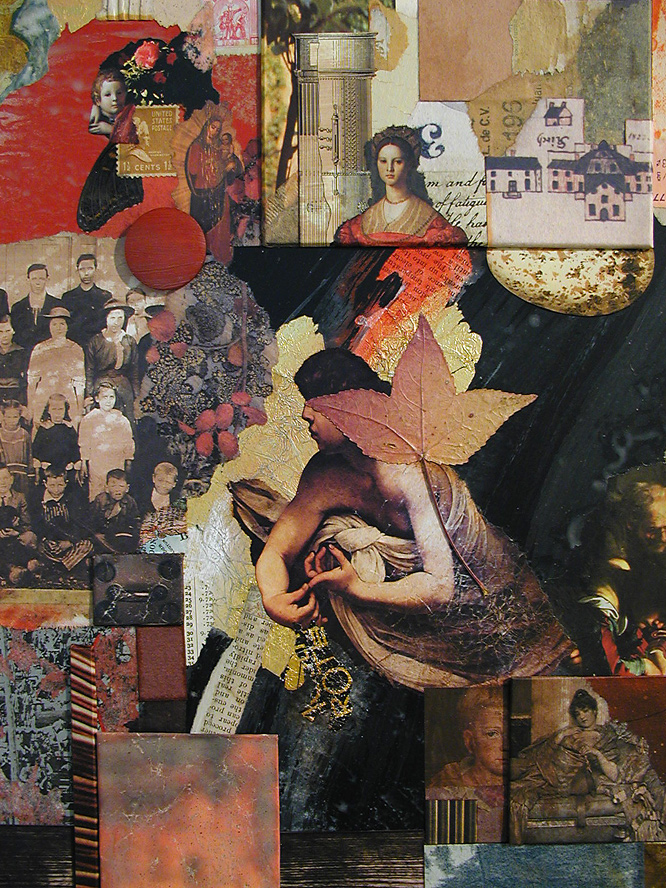 In addition to displaying a pair of shadow boxes, my only surrealist assemblage, and six favorite collage miniatures, JUXTAPOSE provides an opportunity to exhibit Bull’s-eye Nosegay for the first time, which I created for the Target Practice Project initiated by L T Holmes. Also, I did two larger collage artworks especially for this show. Each makes more than a fleeting nod to artists who I admire. What is it about Cherry Balm that causes me to think I just might be “tipping my beret” to the inimitable Matthew Rose? Reliquia is my tribute to the late Fred Otnes, a giant within the medium who has been a force in my consciousness since adolescence. Pearallelograms was held over from the previous exhibition at the institution, but the crowning delight for me may well be the presence of Kentucky Madonna, last year’s “finish” by Robert Hugh Hunt to my “start.” The collaborative piece is a companion to one currently hanging with the IT TAKES TWO exhibition of collaborations at the Kentucky Artisan Center in Berea. Robert and I can’t ask for more than to know that both are now available for public observation (unless someone wants to give them a good home).
In addition to displaying a pair of shadow boxes, my only surrealist assemblage, and six favorite collage miniatures, JUXTAPOSE provides an opportunity to exhibit Bull’s-eye Nosegay for the first time, which I created for the Target Practice Project initiated by L T Holmes. Also, I did two larger collage artworks especially for this show. Each makes more than a fleeting nod to artists who I admire. What is it about Cherry Balm that causes me to think I just might be “tipping my beret” to the inimitable Matthew Rose? Reliquia is my tribute to the late Fred Otnes, a giant within the medium who has been a force in my consciousness since adolescence. Pearallelograms was held over from the previous exhibition at the institution, but the crowning delight for me may well be the presence of Kentucky Madonna, last year’s “finish” by Robert Hugh Hunt to my “start.” The collaborative piece is a companion to one currently hanging with the IT TAKES TWO exhibition of collaborations at the Kentucky Artisan Center in Berea. Robert and I can’t ask for more than to know that both are now available for public observation (unless someone wants to give them a good home).
I am no art historian, but I can’t help but be mindful of the pioneering artists who laid a hundred-year foundation for the sweeping diversity of this exhibition. The creative innovations of Picasso, Braque, Duchamp, Schwitters, Höch, Cornell, Johnson, and Kolář reverberate throughout the building. In many respects, all contemporary collage/assemblage is a tacit homage to these seminal influences, but that is never the only thing at work nor the only phenomena to be perceived when one indulges an exhibition of this scope. Most artists are striving for a personal means of expression informed by those who have made their enduring mark on a medium. I am convinced, more than ever, that what distinguishes contemporary collage/assemblage artists is their keen connection to the mundane “stuff” of culture and the inner need to bring a measure of order and harmony from the sheer volume of material produced by our throw-away society, with its chaotic effect on our sensibilities — to create value where none exists, or to find wonder, meaning, significance, and beauty where none can be expected.
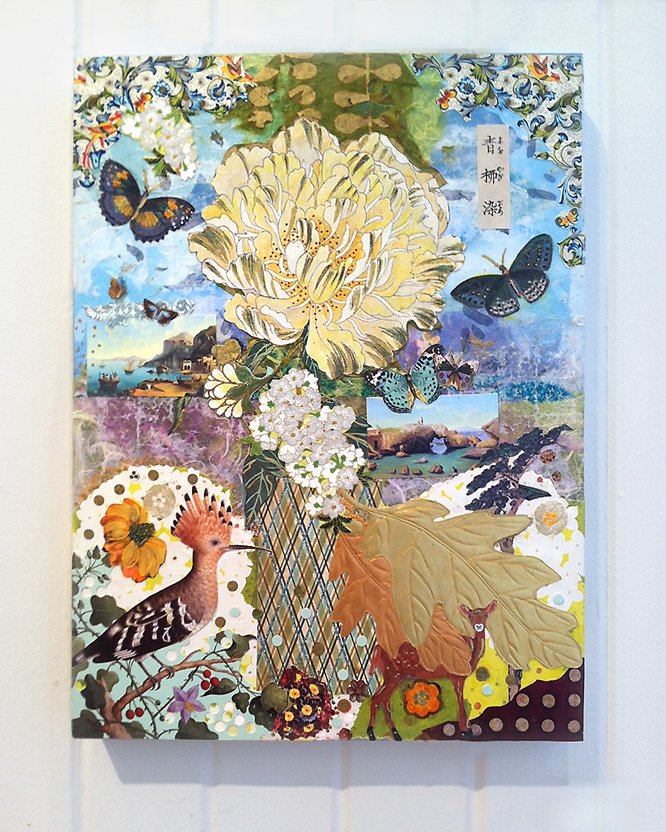
Japanese Peony Goes to Italy
Meg Higgins
collage on wood panel
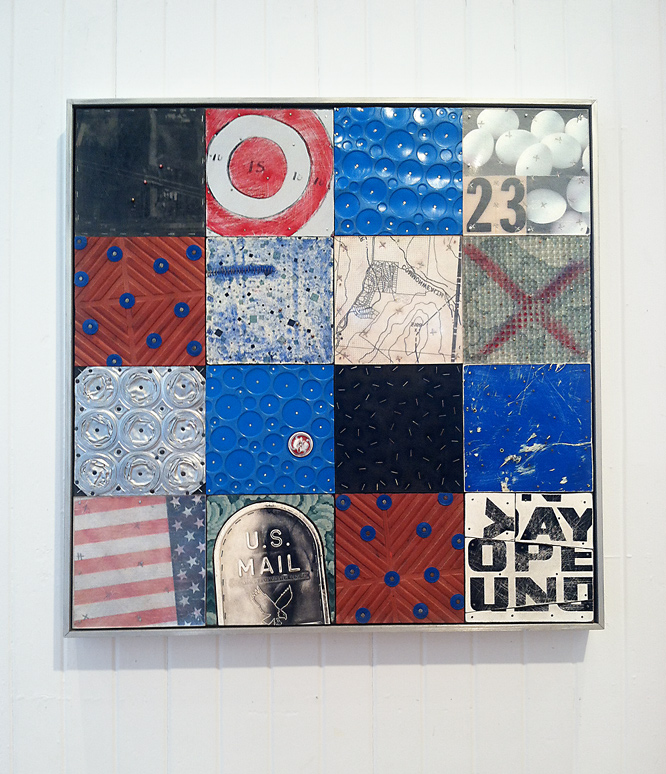
Open Sunday
Brad Devlin
assemblage, found objects
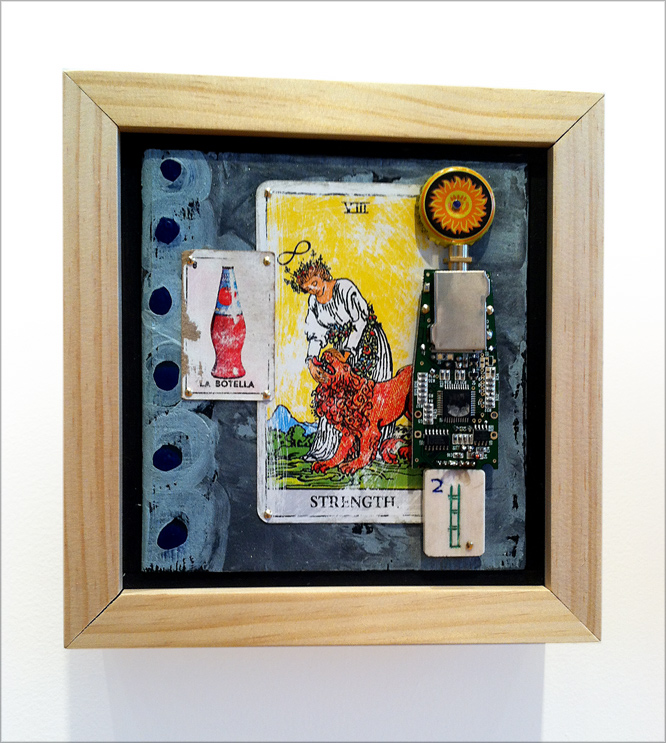
Strength
Patrick Donley
mixed-media on wood
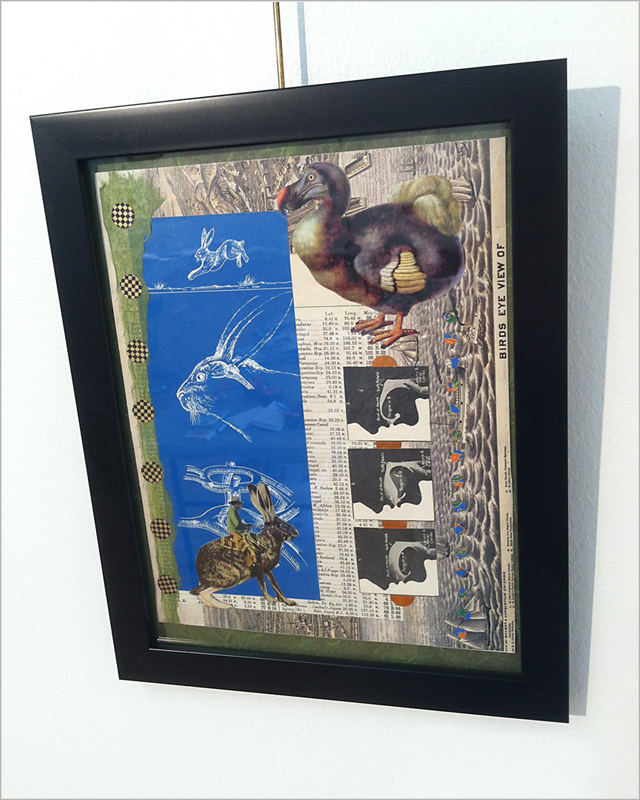
Bird’s Eye View
Lisa Austin
collage
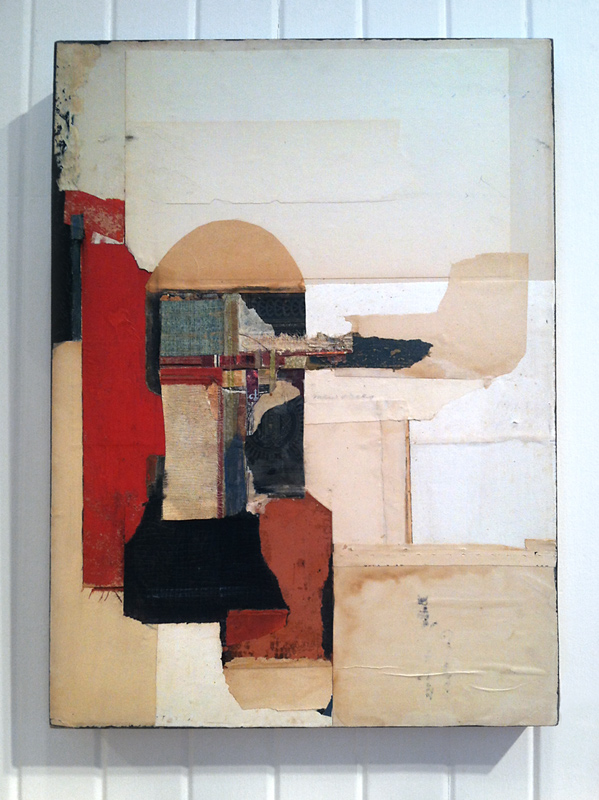
Monteith’s Marrakesh
Teri Dryden
collage from discarded books on panel
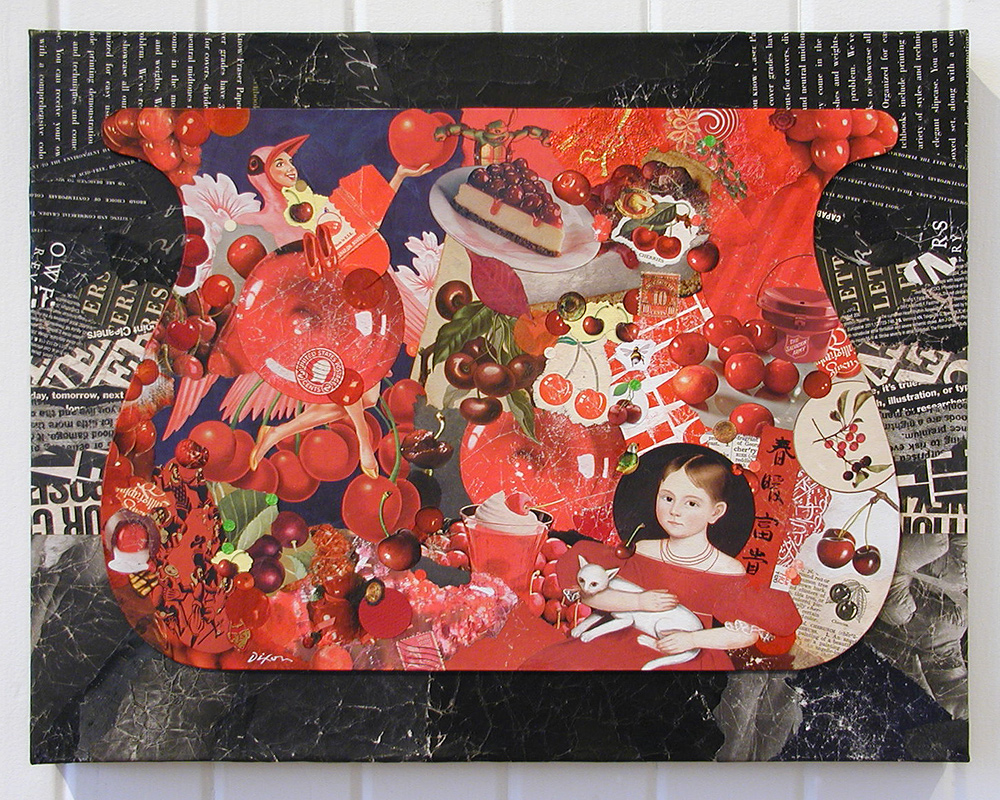
Cherry Balm
John Andrew Dixon
collage on canvas
available for purchase
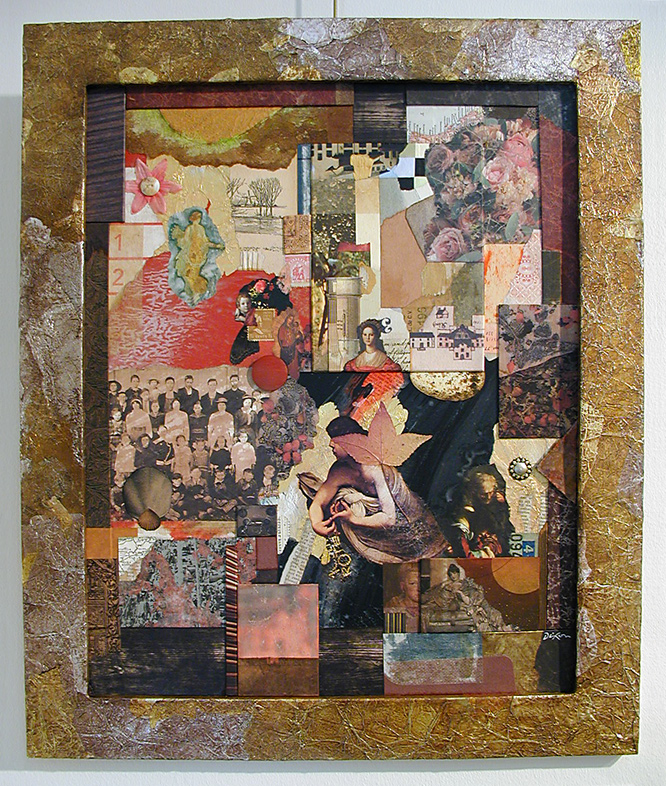
Reliquia
John Andrew Dixon
collage on framed panel
• S O L D
Posted in 1) Available!, Artifacts, Assemblage, B Devlin, B Long, C E Beale, Collaboration, Collage, Dada, Exhibitions, F Otnes, Fruit Series, G Braque, H Höch, Homage, Influences, Ingredients, J A Dixon, J Cornell, J Kolář, K O’Brien, K Schwitters, L Austin, L T Holmes, Larger Works, Layerism, Links, M Duchamp, M Higgins, M Rose, Methodology, P Donley, P Picasso, R H Hunt, R Johnson, Surrealism, T Dryden, T R Flowers, Technique | No Comments »
Monday, August 3rd, 2015
“Shadow boxes become poetic theater or settings wherein are metamorphosed the elements of a childhood pastime.”
— Joseph Cornell
The creations of Joseph Cornell are small, and remained so throughout his unusual life as an artist, even as many of his contemporaries responded to the fashion of producing ever larger works. For me, a salute to this influential American seemed like the fitting approach when I decided to enter notBIG(3), an annual juried exhibition devoted to small art. I am pleased to have had a piece accepted to this show, which hangs from 8/11 to 9/11 at Lexington’s M S Rezny Studio/Gallery.
The “poetic theater” of little shadow boxes is not an isolated medium in collage/assemblage. To consider one’s activity in this comprehensive oeuvre as anything but an homage to Cornell would be an act of mild self-delusion. His singular, enduring presence overarching the genre must be acknowledged. There was a concern that my taking this approach with the notBIG(3) entry might appear to the juror as too derivative, but I pushed ahead with the “sincere flattery” of my plan. I had failed to crack this competition in its previous calls to artists, and I had hopes that the third time would be a charm for me. In addition, I wanted to assemble a range of ingredients outside my norm, including metal, wood, organic material, glass vials, and vinyl dimestore figures.
I created and entered two works as a pair — Histopia and Hertopia — a dual allusion to Utopia Parkway and its significance to the art history of the 20th century. It was not possible to enter both as a combined entry because the dimensions would have exceeded the size limitation of 12 x 12 inches. Only the first shadow box was selected. I was delighted to learn of my getting in the show, but it came with a small serving of disappointment, knowing that the gender balance of my overall idea would be lost with the “boy scene” presented to viewers by itself. It is something I can accept. Out of 380 works submitted, the 45 artists who make up the exhibition have a single artwork included. At any rate, this is what blogsites are for. Both pieces can be viewed together, and I have the opportunity to explain the whole thing to anyone kind enough to read this far. I also anticipate that many of you will be able to visit what appears to be shaping up as a strong exhibition. The opening reception is Friday evening, August 14th, 5 to 8 pm.
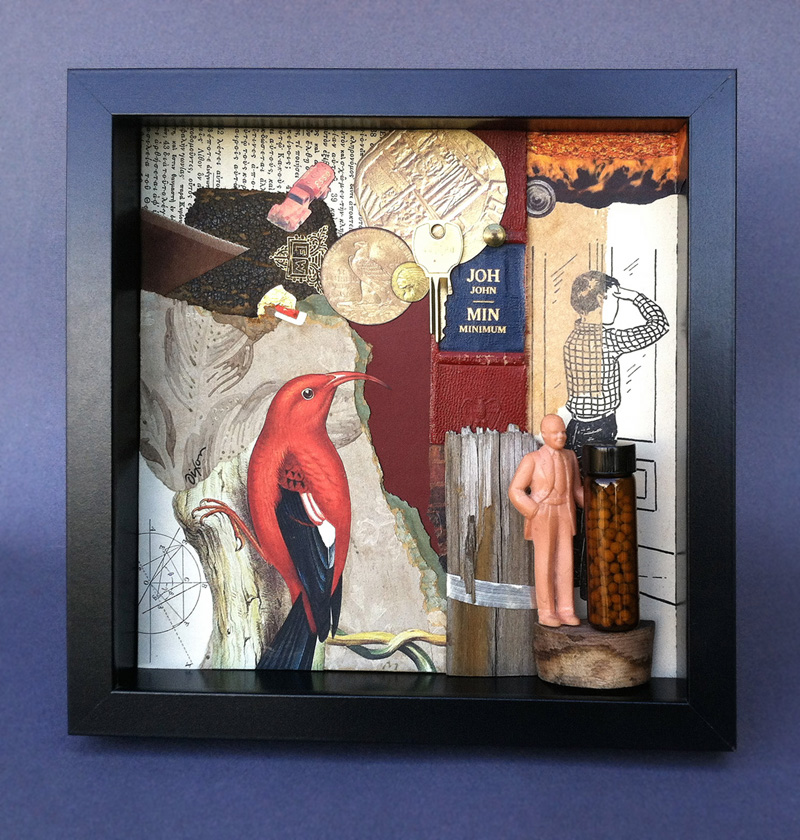
Histopia
collage/assemblage in shadow-box frame by J A Dixon
10 x 10 x 1.75 inches, available for purchase
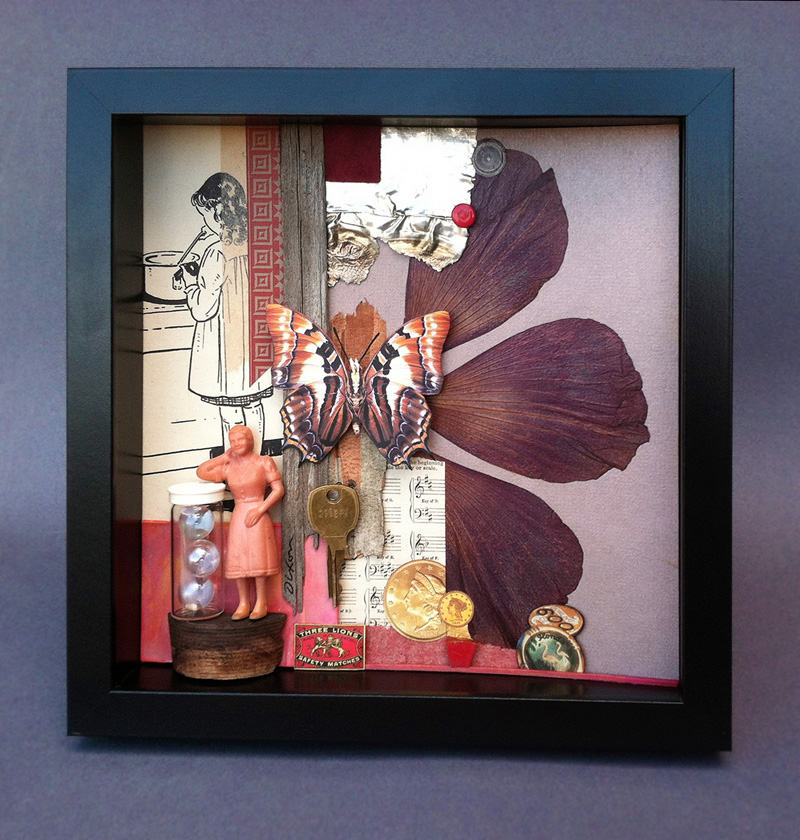
Hertopia
collage/assemblage in shadow-box frame by J A Dixon
10 x 10 x 1.75 inches, available for purchase
Posted in 1) Available!, Assemblage, Collage, Constraints, Exhibitions, Homage, Influences, Ingredients, J A Dixon, J Cornell, Links, Nostalgia, Surrealism | No Comments »
Thursday, December 11th, 2014
“ . . . what I am hoping to do is discover if it is possible to separate nostalgia and collage art, or determine whether the two are inextricably entwined.”
— Joel Lambeth
In a blog entry last month, collage artist Joel Lambeth asked the challenging question, “Is collage inherently nostalgic?” It is one of the more provocative pieces about our medium that I have read this year, although a bit wordy in places. Admittedly, most working collage artists like us who maintain blogs that purport to be more than an online portfolio are not the finest writers alive, and I salute him for not choosing to approach the topic in a superficial way. Nevertheless, it is always risky to generalize about anything, but Lambeth cuts deeply into the subject to probe the history and heart of collage as an art form, and he manages to avoid a semantic discourse on the definition of the word “nostalgia.” His thoughtful viewpoints have sparked a desire on my part to weigh in (with what also may prove to be an entry more verbose than usual).
The groundbreaker Max Ernst worked with vintage engravings, perhaps to emphasize his anti-traditionalist intentions.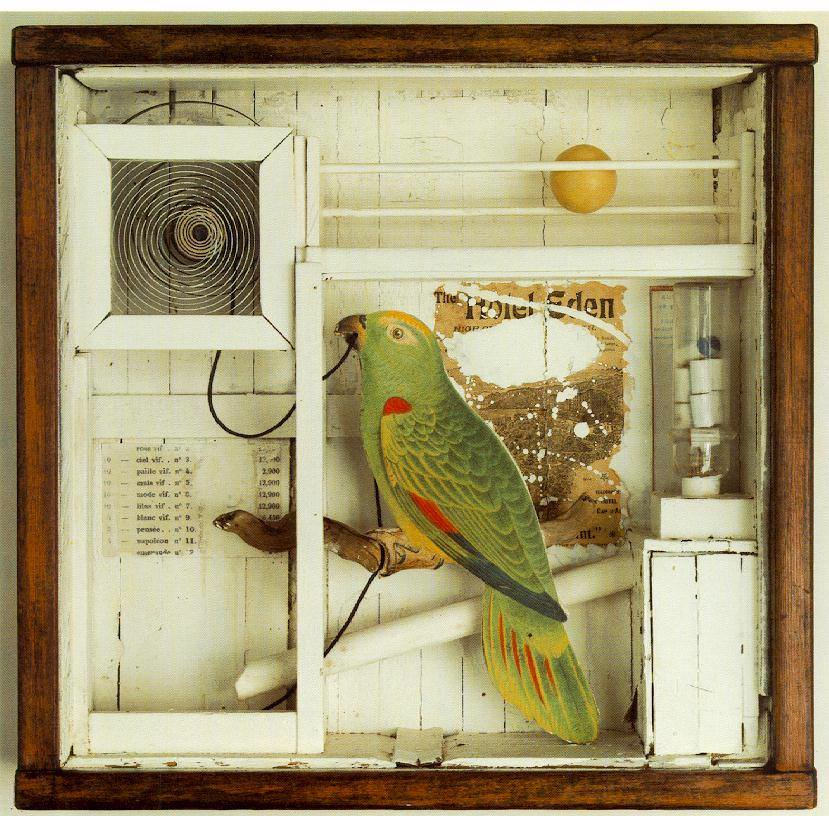 He influenced Joseph Cornell, who captured feelings of personal nostalgia with innovative effects that were as cutting-edge as they were fixated on musings about the past. When analyzing collage artwork with respect to the idea of nostalgia, we must take into consideration the artist’s motivation in addition to the overall character of the medium. When I look at current examples from the daily waves of creative output, it is clear that nostalgia in collage plays out along a spectrum or continuum like nearly every other feature of the process, whether it be minimalism/maximalism, realism/surrealism, or representation/abstraction.
He influenced Joseph Cornell, who captured feelings of personal nostalgia with innovative effects that were as cutting-edge as they were fixated on musings about the past. When analyzing collage artwork with respect to the idea of nostalgia, we must take into consideration the artist’s motivation in addition to the overall character of the medium. When I look at current examples from the daily waves of creative output, it is clear that nostalgia in collage plays out along a spectrum or continuum like nearly every other feature of the process, whether it be minimalism/maximalism, realism/surrealism, or representation/abstraction.
It is surprising to me how many contemporary collage artists work exclusively with old ingredients, but that does not mean necessarily that their agenda is merely to traffic in sentimentality. Sara Caswell-Pearce and Nancy Gene Armstrong are among those who appear to harness nostalgia as a conscious objective in their work while achieving a broad balance of artistic creativity. Many collage artists, such as Carolina Chocron, Nikki Soppelsa, Ross Carron, Fred Litch, Laura Collins, and Frank Voigt are more apt to generate nostalgic tones as a byproduct of incorporating vintage ingredients into strong compositions. Only these individuals could clarify to what degree they actively try to convey impressions of an era gone by. The versatile Zach Collins and Randel Plowman, although they frequently work with obviously old paper, both seem to be engaged in ongoing visual investigations more primary than any sense of nostalgia embedded in their finished works.
Lambeth compares the nostalgic impulse to the process of collage itself and concludes by suggesting “that at a very base level collage and nostalgia have more in common than they do separating them.” He acknowledges the contemporary effort to transcend the inherent bias that the medium may have toward nostalgia. Perhaps he, Marc Deb, Launa Romoff, Andrew Lundwall, Teri Dryden, and numerous other artists are making the push beyond any fundamental nostalgic essence. If so, collage, after more than a hundred years, is cycling back to its roots, when Kurt Schwitters, who always considered himself a painter, became convinced that the pasted detritus of his environment was equally as legitimate as a brushstroke of oily pigment.
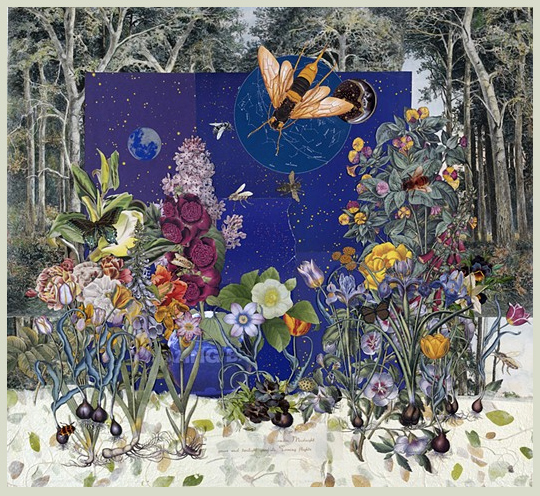
Midnight Gambol: Or Why The Bees Slept In Every Morning
mixed-media collage by Sara Caswell-Pearce
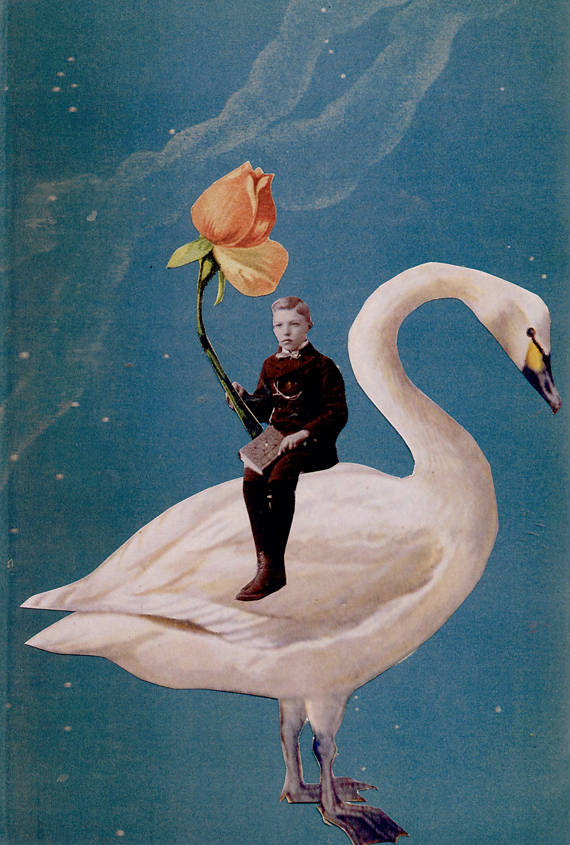
A Boy and a Swan
collage by Nancy Gene Armstrong
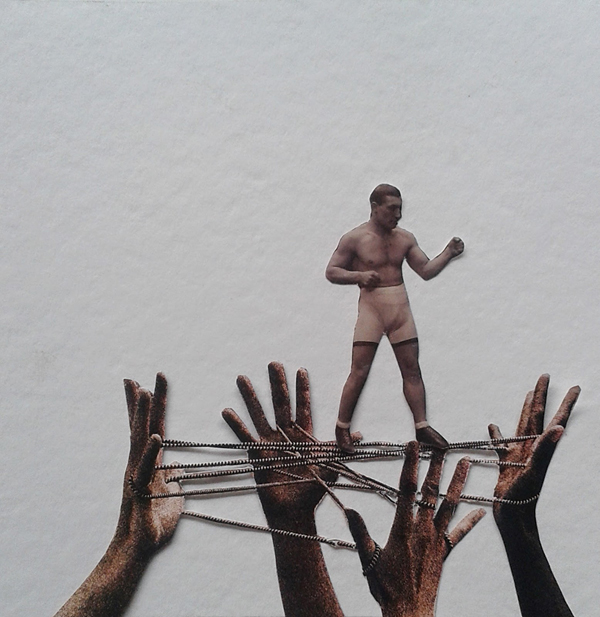
descosiendo el cuadrilátero
collage by Carolina Chocron
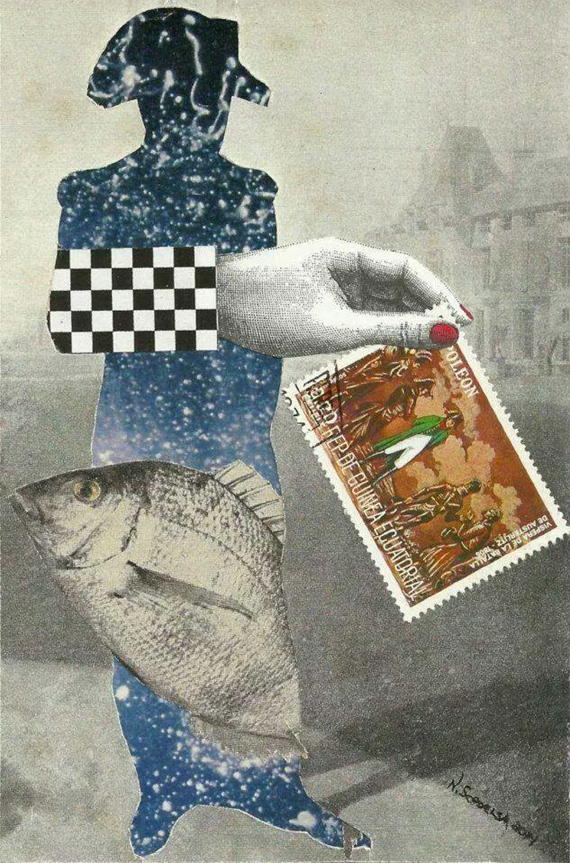
Napoleon shows his hand
collage by Nikki Soppelsa
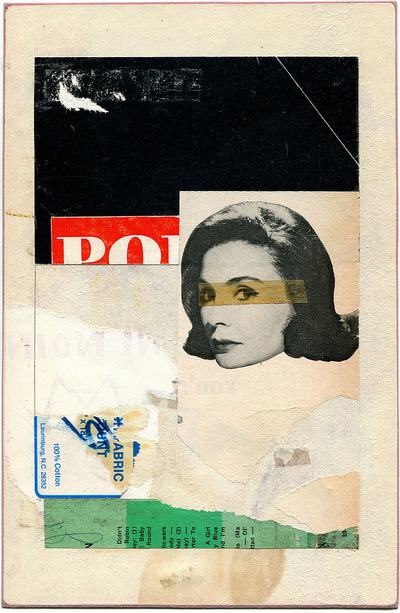
untitled
collage by Fred Litch
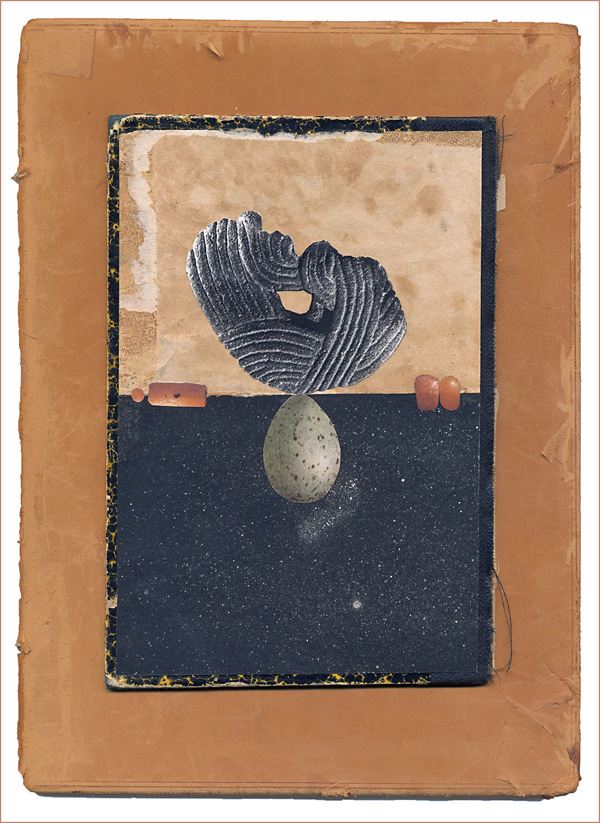
Nubecula Cum Ovi
collage by Ross Carron
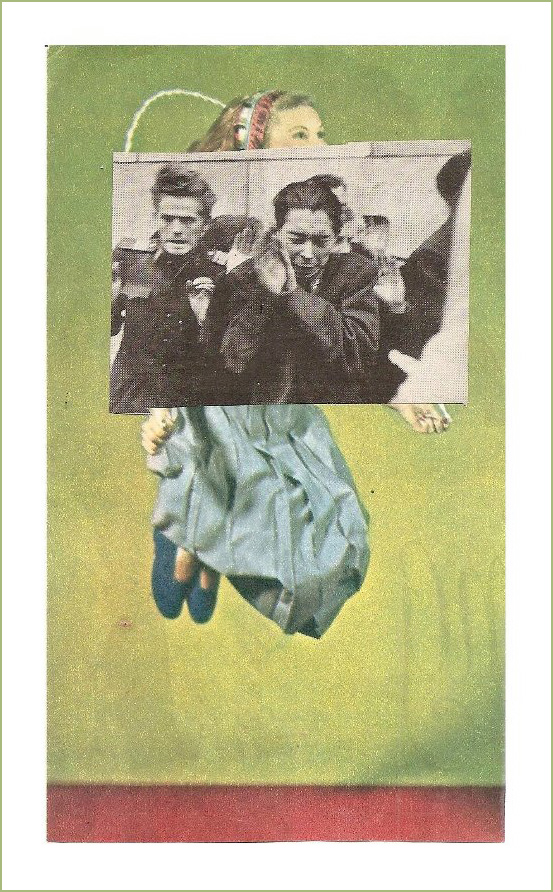
Jump
collage by Laura Collins
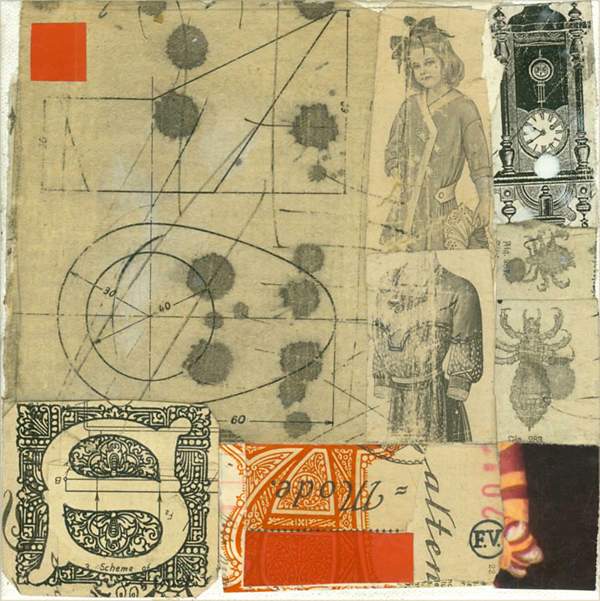
untitled
collage by Frank Voigt
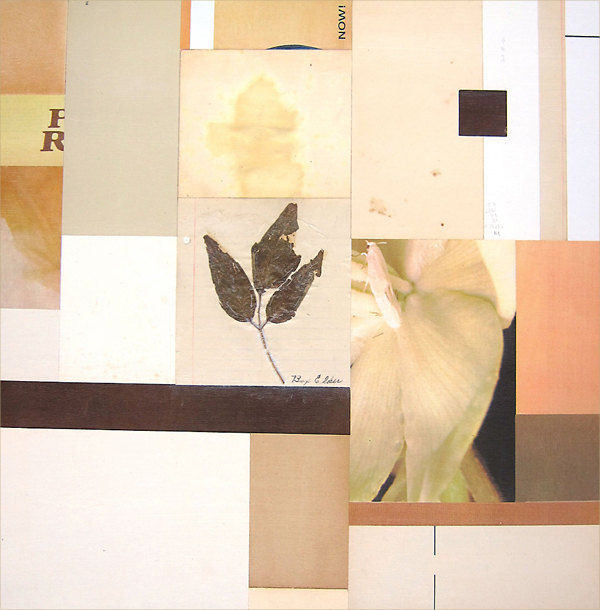
141zc14
collage on wood panel by Zach Collins
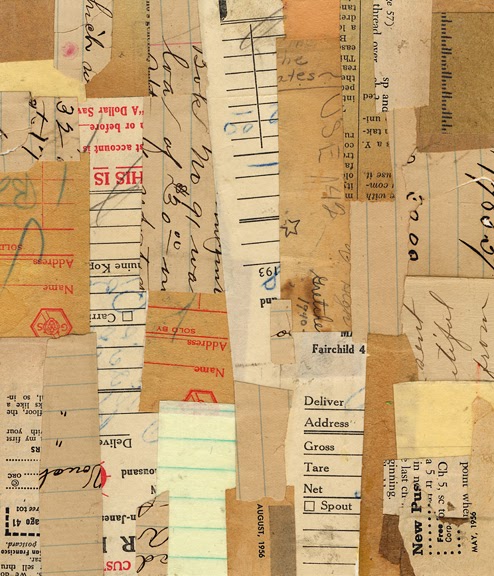
August Night
collage by Randel Plowman
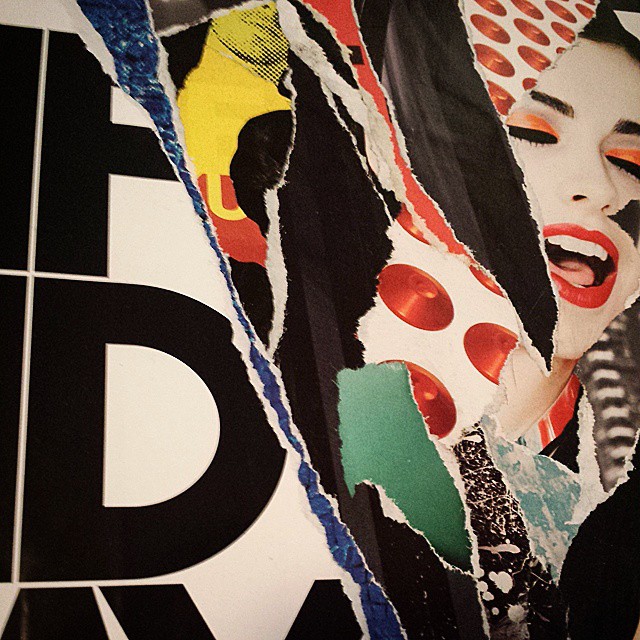
Ripping It Up
collage by Joel Lambeth
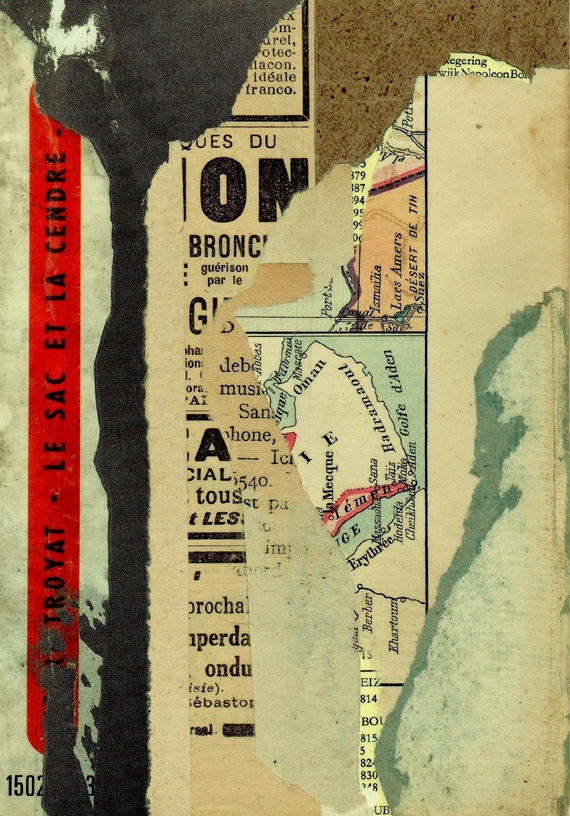
Imperfect Parallels
collage by Marc Deb
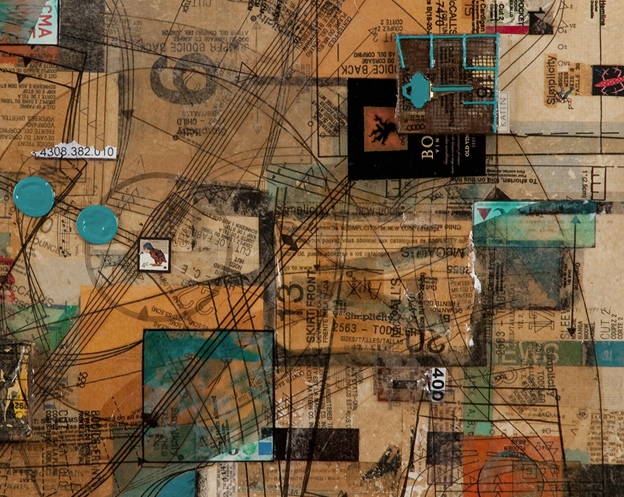
the parrot (detail)
mixed-media collage by Launa D Romoff
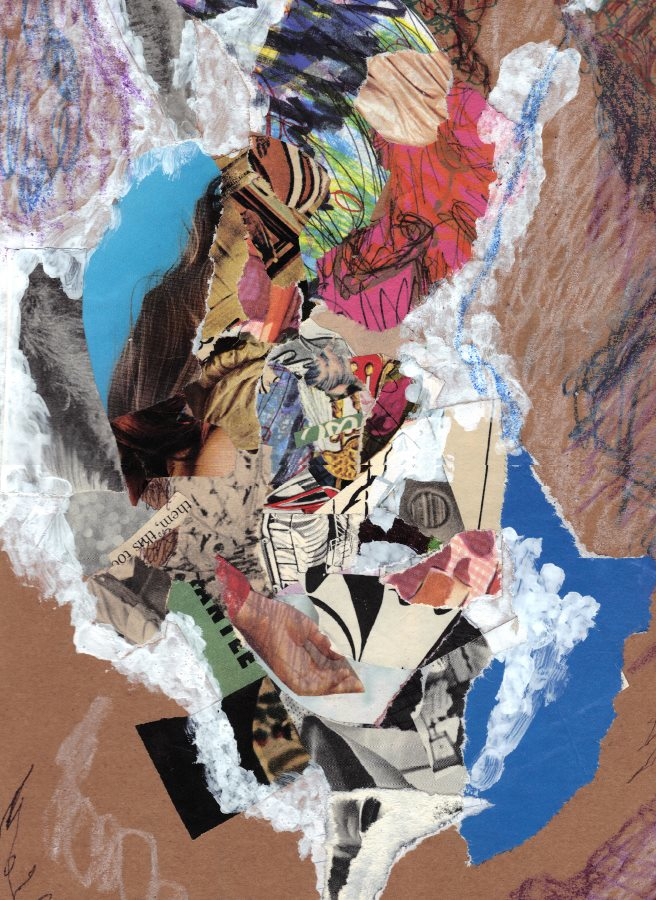
Substance
mixed-media collage by Andrew Lundwall
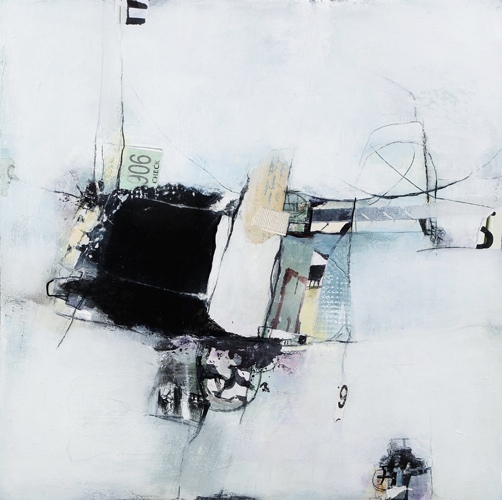
9 Lives
mixed-media collage by Teri Dryden
Posted in A Lundwall, C Chocron, Collage, Combined Mediums, F Litch, F Voigt, Influences, J Cornell, J Lambeth, K Schwitters, L Collins, Links, M Deb, M Ernst, Methodology, N G Armstrong, N Soppelsa, Nostalgia, R Carron, R Plowman, S Caswell-Pearce, T Dryden, Z Collins | No Comments »
Thursday, July 3rd, 2014
“The project has become The Book About Living.”
—Sonja Benskin Mesher
Ray Johnson, the original “most famous unknown artist in the world,” produced his A Book About Death during the years 1963 to 1965. The pages were randomly mailed and offered for sale. Complete copies were compiled by a rare few. Johnson was a significant bridge between the groundbreaking work of Schwitters, the sensibilities of Cornell, and the emergence of what would become the most widely recognizable features of Pop Art. He was highly influential in the Mail Art, Installation Art, and Performance Art movements, as well as late 20th-century neo-Dadaist trends.
Since 2008, Paris-based Matthew Rose has actively aroused a worldwide interest and vitality that perpetuates the legacy of A Book About Death. A new call to artists from the Royal Cambrian Academy in Wales and the full history of ABAD can be studied at this site. An exhibition at MoMA Machynlleth planned for later this year will include a collage from me (featured below, produced on a 50-year-old postcard). An online archive will share details of the exhibition and record artworks as they come in. Participate! You have until September 30th to mail your contribution.
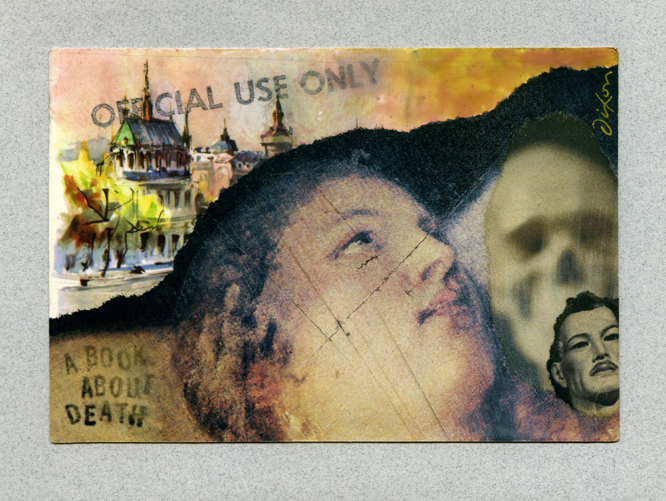
ABAD 2014
collage on 1964 postcard by J A Dixon
6 x 4 inches, not for sale
Posted in Dada, Exhibitions, Influences, J A Dixon, J Cornell, K Schwitters, Links, M Rose, Mail Art, Pop Art, R Johnson | No Comments »
Monday, June 9th, 2014
“We need a little confusion.”
— Neil Gaiman
The Great American Brass Band Festival’s milestone 25th event is now in the archives. The finale was one of the most satisfying concerts in the history of the Kentucky festival. My appreciation goes to those who made it all happen one more time! I am pleased to have played a small part.
When I was first approached about lending my creative experience to the effort, I pitched the idea of a traditional collage to mark the 25th, using scraps from memorabilia of the last quarter century. A decision was made to go a different direction, but I could not put the idea aside. The result is “Brass 25,” a tribute to my community’s exceptional contribution to the American musical and cultural scene.
Is “commemorative collage” art? Perhaps not. Some might make the case that no example of the medium has approached “high art.” In my opinion, such a viewpoint fails to consider the 100-year impact that the medium has had on our visual landscape and the evolution of our aesthetic perceptions. It neglects the seminal role of Schwitters, Höch, Cornell, Kolář, and others. For me, the core relationship between mundane material and the art of collage transmits a unifying principle. When the remnants of ordinary life are physically re-purposed to resolve a unique compositional harmony, the culminating artifact can achieve a transcendent tone and offer a shared experience with each participating observer. If that is not art, stripped of elitist notions, then what is?
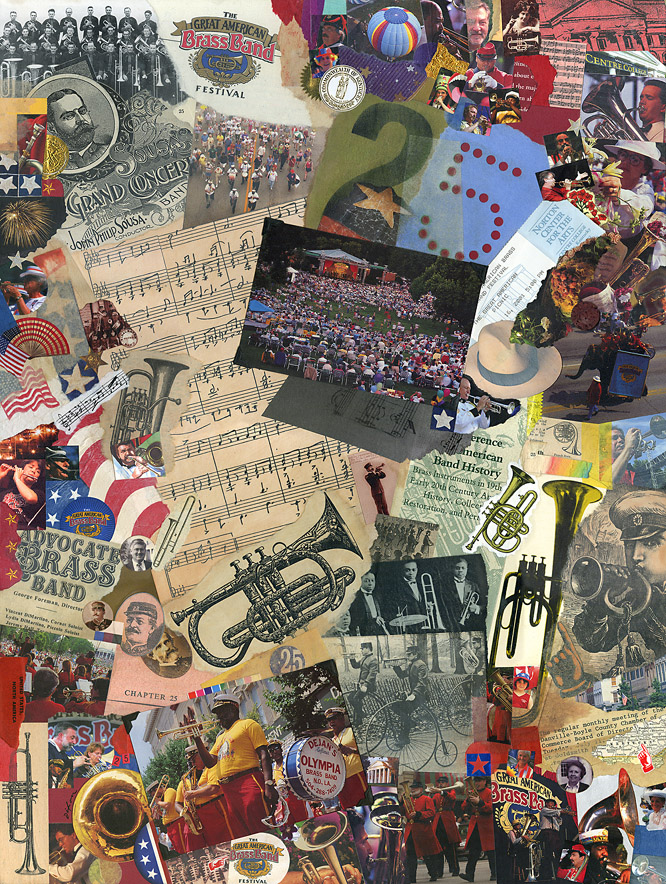
Brass 25
commemorative collage by J A Dixon
17.5 x 23.5 inches
available for purchase
Posted in 1) Available!, Applied Arts, Collage, H Höch, Illustration, Influences, J A Dixon, J Cornell, J Kolář, K Schwitters, Larger Works, Methodology | No Comments »
Friday, July 12th, 2013
“Any fool can carry on, but only the wise man knows how to shorten sail.”
— Joseph Conrad
Looking back on a full year as a blogger, many of my initial objectives have been met, but there are even more subjects to tackle in the coming months. Can I find the right balance between words and images, welcoming others to act as better scribes for what is happening in collage and remembering that I would rather be holding a pair of scissors than typing at a keyboard? The exceptional print quarterly out of Canada, Kolaj, has also celebrated its first birthday. 2012 was the perfect year to salute a century of collage as a modern art and also to look around, assessing the current maturity of the practice. I still have much to say about the pioneers and exemplars — Gris, Schwitters, Hausmann, Höch, Cornell, Hamilton, Johnson — for there is much to observe and absorb about their seminal talismans and bodies of work.
It is equally important to evaluate more of the leading and emerging artists now actively producing what may be known as “post-centennial collage,” perhaps the most vital period of cross-pollinated output in the medium’s history. Where to focus next? Those who magnify the traditions of Dada, Surrealism, Fluxus, or Layerism? Dedicated collage abstractionists such as Touchon, Dryden, Romoff, or Gordon? Masters of the outer reaches of a Maximalist/Minimalist spectrum such as Kroll, Reitemeyer, or De Blauwer? I have for some time lamented the lack of a visual-arts phenomenon equivalent to how musicians have traditionally improvised together, but my recent awareness of dynamic collaborations between collage artists is forcing me to change my mind. Is it time for me to take a closer look at the creative fusions instigated by Collins, Holmes, Daughters, or Wilkin?
My, my . . . have we just laid out another year or more of entries? And I have not yet “scraped the working surface” of all the collage artists who make the contemporary scene so exciting. Do I possess the necessary wisdom to tame my ambitions and “shorten sail?” My mind rebels at the idea that I cannot be an artist and a writer, too. I am no scholar, and some art historians would scoff at my correlations, but I cling to the notion that there is a place for insights about our medium that can come only from a person who faces the same challenges as my working peers when confronting a pile of scrap.
One more thought: As the digital age sweeps over the planet, is there also taking place a not-so-quiet backlash against the erosion of manual dexterity? If so, is there a more compelling counter-trend example than the current explosion of tearing, cutting, assembling, transferring, and pasting? And beyond the familiar “analog” technique, what can be said about the deep influence of visual collage on the preponderance of montage in all things sensory — music, performance, film, and media design? This site can become a place where all of this is explored, discussed, shared, and challenged. Much of that is up to you, valued reader. Meanwhile, I shall continue to see, write, and make more art. Stop by again, soon!
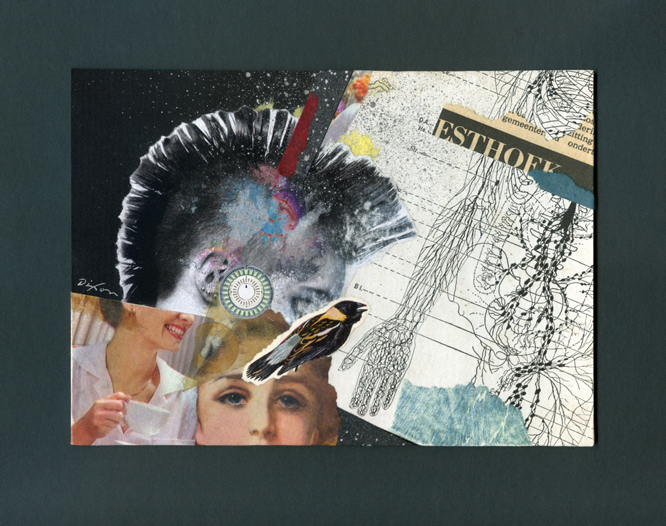
Every Instinct of My Being Rebels
collage miniature by J A Dixon
7 x 5 inches
Purchase this artwork!
Posted in 1) Available!, Artists/Collage, Blog Years, C Touchon, C Wilkin, Collaboration, Collage, D Daughters, Dada, Fluxus, H Höch, H Kroll, I Reitemeyer, Influences, J A Dixon, J Cornell, J Gris, K De Blauwer, K Schwitters, L Romoff, L T Holmes, Layerism, Links, Maximalism/Minimalism, Music, Publications, R Hamilton, R Hausmann, R Johnson, R K Kadour, S Gordon, Surrealism, T Dryden, Z Collins | No Comments »
Monday, June 24th, 2013
“Less is not necessarily more.”
— Milton Glaser
A profusion of collage artwork has recently come to my attention that makes use of only two or three elements. When this type of minimalist approach is successful, the result can be quite arresting to the eye and mind. More often than not, it looks uninteresting or unfinished to me. It may come as no surprise that I am more of a maximalist, preferring to build a layering of ingredients that transcends the intrinsic quality of the found material. I suppose that I have been more influenced by Schwitters than Cornell. Although there is nothing inherently unappealing to me about “sparsity,” admiring those who employ the methodology with skill, I have found myself pulled toward “density’ for the past few years. Some artists may think that if one hasn’t achieved a solution with fewer than a dozen parts, the essence of the piece has escaped. I appreciate that viewpoint, and respect those who consistently meet the challenge of limitation. For me, the working surface calls out for more, until a balance of “visual polyphony” takes form, and the dynamic aspects of color, shape, composition, and symbolic communication have resolved themselves as a distinctive, unified whole.

Fallen Body
collage artifact by J A Dixon
7.5 x 10.5 inches
available for purchase
Posted in 1) Available!, Artifacts, Collage, Influences, Ingredients, J A Dixon, J Cornell, K Schwitters, Links, M Glaser, Maximalism/Minimalism, Methodology | No Comments »
 I’m still feeling a satisfying vibe from one of the most personally rewarding events ever! My hands-on collage workshop was part of the “Train the Trainer“ series in Paintsville, Kentucky for the Johnson County Extension Office. Participating artists intend to share this learning throughout their community in the coming months. My thanks to a fabulous group of creative individuals who were curious about “all things collage” and inspired to “pay it forward” among fellow citizens in their beautiful area of our Commonweath.
I’m still feeling a satisfying vibe from one of the most personally rewarding events ever! My hands-on collage workshop was part of the “Train the Trainer“ series in Paintsville, Kentucky for the Johnson County Extension Office. Participating artists intend to share this learning throughout their community in the coming months. My thanks to a fabulous group of creative individuals who were curious about “all things collage” and inspired to “pay it forward” among fellow citizens in their beautiful area of our Commonweath.































































